Moira Butterfield's Blog, page 38
June 24, 2018
Writing an accidental Picture Book Series by Chitra Soundar
I didn’t start out to write a series of picture books. But now I realise I’ve one successful series and another one edging in that direction.
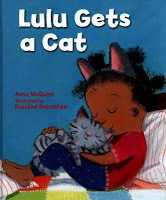
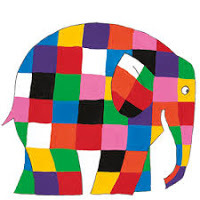 I’ve always been a fan of series fiction – whether as chapter books or as picture books. When I fall in love with a character, be it Elmer or Lulu, I love to read other stories about them. I want to see them do different things.
I’ve always been a fan of series fiction – whether as chapter books or as picture books. When I fall in love with a character, be it Elmer or Lulu, I love to read other stories about them. I want to see them do different things. But as a writer, I always knew that a series is something you can plan for, but actually getting to publish one, is not up to me. So even though I never intended to write one, I stumbled on to a series.
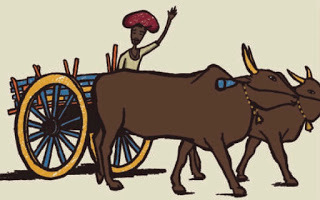 The Farmer Falgu series originated in India and is now available worldwide in many languages. And this is how it started.
The Farmer Falgu series originated in India and is now available worldwide in many languages. And this is how it started.I wrote a story about silence and the joyfulness of noise set in an Indian farmer’s life. I wanted the story to have musical elements and I wanted my farmer full of positivity. I didn’t have an idea that I was creating a friend for myself.
After I submitted the story and it was accepted, I happened to realise another one of my story ideas will fit this character. So I asked the publisher if they would accept another story for the same character. Now this was even before an illustrator was chosen for the first. While the first one focussed on sound, the second one was all about food.
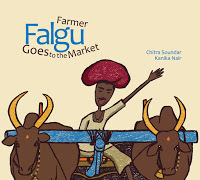 It was a gamble but the editor said yes and to my delight both Farmer Falgu Goes on a Trip and Farmer Falgu Goes to the Market is available in many different languages – from French to German to Japanese and American English.
It was a gamble but the editor said yes and to my delight both Farmer Falgu Goes on a Trip and Farmer Falgu Goes to the Market is available in many different languages – from French to German to Japanese and American English.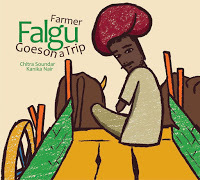 The success of the first two books both in India and abroad, triggered a commission of two more stories. And a series was born.
The success of the first two books both in India and abroad, triggered a commission of two more stories. And a series was born.But the thing about series is, especially one that has become popular is, there’s more at stake. I wrote so many different stories for the same character, trying to find the third and the fourth I was commissioned.
But the 3rd and 4th book would not have been possible if I wasn’t doing extensive research on both Farmer Falgu and India in particular looking for stories.
Farmer Falgu was completely a product of imagination and a series of accidental events. So after I created the character, I did a lot of research on his back story. I had chosen a name that happened to have historical significance. And that was a happy accident. The illustrator had set him in Rajasthan and that was another happy accident for me (although she would have made a conscious choice).
So I researched the background of the state, created resources and activities for kids. This led to my researching the kite festival, which then turned into an idea for Book 4.
Researching India and having a discussion with the publisher gave me another idea – the Kumbh Mela – the biggest festival on earth. I loved that it had all the elements I love in a story and in life – rivers, trains, food, elephants and a Farmer Falgu who couldn’t catch a break. Or did he?
So as I wrote Book 3 and 4, I learned some key things about writing an unplanned, accidental series.
a) The character now has a life of his own. And therefore the story has to fit this life. As the illustrator Kanika Nair made him a Rajasthani farmer, the new stories needed to fit his new life in Rajasthan and what happened there.
b) The throughline – the first two stories had unconsciously created a personality, a theme and an ethos for my character. He was a glass-half-full guy and therefore any new story needed to fit his ethos.
c) The Economics: Three or four books of the same character, the same author-illustrator duo is an investment for a small independent publisher from India. They had to be really sure that the 3rdbook and the 4th book would work. So there was a lot more scrutiny, review and discussion before these stories were even written.
d) The expectations: These stories showcased India in a small way and with the first two books having sold in many foreign territories, a need to show some wonderful events or places in India within Farmer Falgu’s life was tempting. We zoomed back from his farm out into a bigger world for Book 3 and 4.
e) Series guidelines: These weren’t written down – but there was a sense of how long the book would be, the pattern, the setting and the title. The first two titles had “Farmer Falgu Goes…”. So I had to make him go somewhere in each story.
As a writer, suddenly I had to work within a framework. Sometimes it felt as if the story didn’t come first, the series guidelines did. But then pushing the story to the forefront and making the character centre-stage helped me plot Book 3 and Book 4.
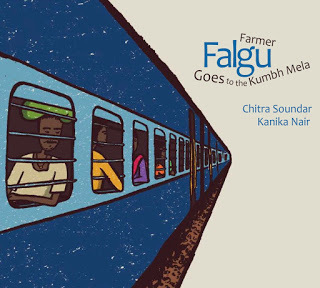 Available in the UK soon through Red Robin Books
Available in the UK soon through Red Robin BooksAs much as there is a pre-defined framework when you work on a series, there are benefits too. If parents and teachers like one of the books in the series, they’re more likely to buy the others. The characters turn into friends. I have Farmer Falgu talking to me at odd times when he sees something through my eyes. But also as a writer I start seeing the world through his eyes.
 Available in the UK soon through Red Robin Books
Available in the UK soon through Red Robin BooksAnd now I’m standing on the edge of another series. Fingers crossed!
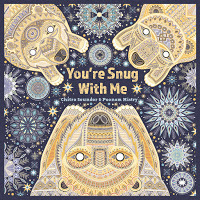
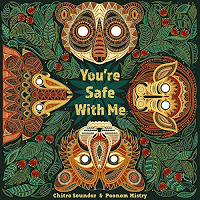 You’re Safe With Me (illustrated by Poonam Mistry) was met with so much love even before it was published that the publisher, Lantana Publishing, commissioned a companion story, You’re Snug with Me. Although it is not the same characters in the second book, a pattern has emerged. Whether there’s a third book, only time will tell.
You’re Safe With Me (illustrated by Poonam Mistry) was met with so much love even before it was published that the publisher, Lantana Publishing, commissioned a companion story, You’re Snug with Me. Although it is not the same characters in the second book, a pattern has emerged. Whether there’s a third book, only time will tell. 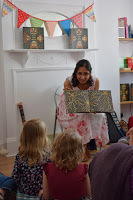 Chitra Soundar is an Indian-born British writer of picture books and junior fiction. When she's not writing stories, she can be seen telling them to both children and grown-ups across libraries, festivals and schools in the UK and worldwide. Find out more at www.chitrasoundar.com or follow her on Twitter at @csoundar.
Chitra Soundar is an Indian-born British writer of picture books and junior fiction. When she's not writing stories, she can be seen telling them to both children and grown-ups across libraries, festivals and schools in the UK and worldwide. Find out more at www.chitrasoundar.com or follow her on Twitter at @csoundar.
Published on June 24, 2018 23:00
June 17, 2018
Ssshhh! When a Picture Book writer embarks on an affair with a Novel. And what have other authors brought from picture book writing to novel writing, and from novel writing to picture book writing? by Juliet Clare Bell
You know when you first start writing, and how you keep your writing habit secret for a while, or only speak about it apologetically? And then once you’ve been doing it a while and feel more confident in your area, you might talk about with more certainty, and maybe you get a book published, and you feel more legitimate again…?
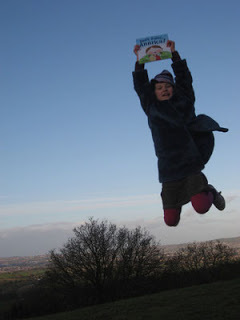
The joy of having your first book published and feeling like a 'real writer'. A young (non-panicking) Annika jumping for joy (on my behalf) at my first book, Don't Panic, Annika! (illustrated by Jennifer E Morris, 2011)
But what about when you feel legitimate in one area of writing but start doing something in a brand new one? Do you have to start again as a complete newbie? What strategies from one can you bring to the other? And can you keep some of that confidence, or do you have to go back to those terrible apologetic conversations with people about what you’re currently writing?
Well in the spirit of allowing yourself to be vulnerable and to take risks in order to be and know who you are (which is central to the story I’m writing), I’m ’fessing up, even though I’m at the early apologetic stage:
I AM WRITING A NOVEL.
I had to delete and change that from ‘I AM TRYING TO WRITE A NOVEL’, the language I’ve absolutely slipped back into now I’m writing in a completely new field. But I am writing one. It may never end up getting published, but I AM writing it, rather than ‘trying to write it’ and I am trying to use what I already know from writing picture books.
I love learning from other people, and so I asked a few children's writer-y friends who have done/are doing both children's novels and picture books, for their thoughts…
First, I wanted to know how easy is it to work on both at the same time?
I asked this because I have so far found it extremely difficult to think about both. It turns out, the writers I asked who liked writing both genres all found the switching easy. Here’s Sophia Bennett, successful, award-winning author of novels including Unveiling Venus, Threads and Love Song …. and who has at least one new picture book out in 2019 (she can't say too much about anything at the moment, but having read a draft of one of them, I can tell you that she is an exquisite picture book writer).
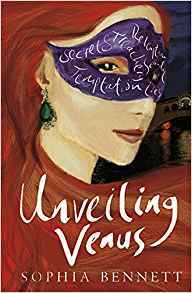
Sophia's most recent novel, Unveiling Venus (Stripes Publishing, 2018)
“Finding the time is extremely difficult. But when I do, I actually love skipping from one to the other, because each one uses different brain space and makes coming back to what I was doing before feel fresh, and a pleasure.”
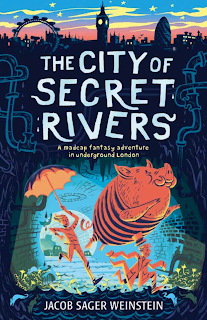
(c) Jacob Sager Weinstein (2017)
Jacob Sager Weinstein is the author of The City of Secret Rivers (an absolute favourite with one of my children), for which he has been shortlisted for the Branford Boase award for most promising new author, and the upcoming picture book Lyric McKerrigan, Secret Librarian (illustrated by Vera Brosgol).
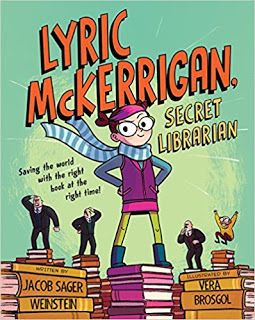
(c) Jacob Sager Weinstein and Vera Brosgol (2018)
He agrees with Sophia:
“In some ways, it’s easier than just working on one kind of book — if I’m not in the right frame of mind for one, I’m often in the right frame of mind for the other. God knows I still procrastinate, but at least I have the option of procrastinating productively”.
Productive procrastination? I look forward to that…
Wendy Meddour, author of many books, including the Wendy Quill series
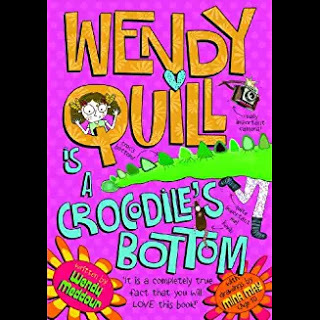
(c) Wendy Meddour and Mina May (2013)
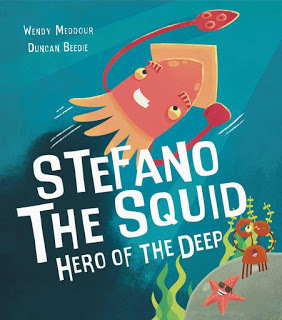
(c) Wendy Meddour and Duncan Beedie. Stefano the Squid, Hero of the Deep will be out with Little Tiger Press
and also finds the shift easy, and does it based on timing:
“I generally treat myself to writing picture books on weekends …and work on novels at night (after I’ve finished work and the kids are in bed)”.
I’m feeling more hopeful now. I had naively thought when I started that I could work on my novel from 6-7am each morning, and then do everything else (picture books, author visits, admin etc) during the rest of the time available and that I could make the switch easily. But unlike the authors, above, I found it almost impossible to think about picture books at all whilst I was in the really early stages of doing the novel. As a picture book writer, I think loads about structure as it’s so critical to a picture book. I knew that I know how to write; I knew I know how to structure a picture book, but what I didn’t know was whether I could structure a novel. And so I made myself work on the structure and get that sorted (including having a description of each scene) before I actually started writing out the story at all. There was no way I was going to embark on a full-length novel if I wasn’t sure I could complete it in a way that made sense (I had started an adult novel about 17 years ago but never got beyond Chapter 3 as I just didn’t have a structure for the whole thing, even though I had hundreds of pages of rough notes about the characters). This was before I’d written picture books, and now I’m used to plotting and I’ve seen how a longer story can crumble so quickly without decent foundations. And, taking to heart the sentiment of Seamus Heaney's wonderful poem (with apologies to him for the spurious connection of his poem to the subject of children's novel writing, as opposed to love -but it's a great poem, and reading, of) Scaffolding I would never embark on such an enormous story without feeling I’d got my scaffolding in order:
Seamus Heaney reading his poem, ScaffoldingAs Sophia says:
“ I do find each novel daunting… knowing I’m going to risk writing for a whole year about something readers may not connect with when it’s done. You never know. That aspect of novel writing seems mad. At least with a picture book it’s quicker!”
Exactly. That’s why it’s taken so long for me even to consider trying to write a novel again. And at least if you have the scaffolding there, you feel more confident that what will stand at the end of it will be solid. Ish. And now, having finished the structure for the first draft, it feels like I don’t have to hold it all in my head anymore; I can just write what I’m told to (by me), looking at each scene description and following its structure. As a picture book writer, this feels much more familiar –and safe- and I am now going to put my Wendy Meddour hat on and write the novel at certain specified times of the week, and picture books at others, and I have just in this last week got back into thinking about picture books again. (Unless I am in need of a bit of Jacob's productive procrastination (thank you, Jacob), in which case I might be really frivolous, and swap...).
So how do the picture-book-and-children's novel writers I spoke with use strategies for plotting and structuring one type of book for the other?
Sophia:
“I am a planner. With all my books - adult, young adult and picture books - I plan and research a lot before I start, and more as I go. Even so, the story moves off in directions I wasn’t quite expecting. With all of them, my core subject is something I’m passionate about, so I put a lot of myself into them.”
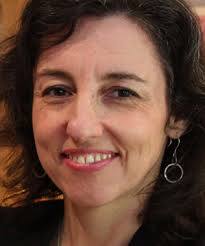
Sophia Bennett
And on using novel writing strategies for a picture book?
“I think of it in various acts! Even though I only have a few hundred words to play with, I have my opening section, the building action, the climax and the resolution. I try and use interesting dialogue. I research a lot, think hard about the characters and have it plotted out in my head before I start, but then let the poetry of the words lead me on as I write.
As I’m new to picture books I don’t really have strategies for it - just an endless learning process. Hopefully I’ll have something to bring from it to the other books eventually. It might be to do with how much you can leave unsaid and still get the message across. I keep finding that the more words I cut, the better it gets.”
Candy, your thoughts?
Candy Gourlay, award-winning author of Tall Story and Shine
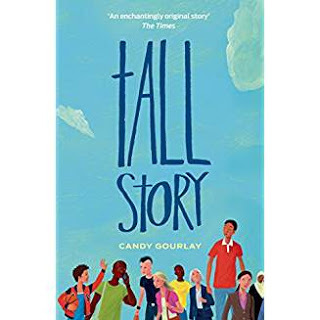
(c) Candy Gourlay, 2010
whose first picture book, Is It a Mermaid? (illustrated by Francesca Chessa, Otter Barry Books, 2018) is just out
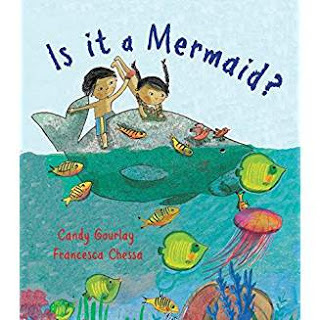
(c) Candy Gourlay and Francesca Chessa (2018)
and whose new novel, Bone Talk (David Fickling Books, 2018) will be out later this year, talked about writing picture books as an author of children's novels:
“because novel writing has a lot to do with structure, I find myself applying longer format structural rules to my picture book writing. Like putting a plot pivot at the very middle of a story. And thinking hard about context and set up to create a satisfying pay off. I do this a million times over the course of writing a novel … so I can chart a reader's emotional arc as they read the novel. But in picture books, you only get one shot at satisfying your reader”.
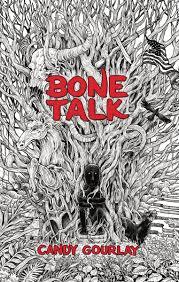
(c) Candy Gourlay (2018)
And Jacob?
“Plot is probably more important in a novel than in a picture book. A picture book can be purely about language or character or a single emotion; a novel needs a well-structured story to drive it forward. For better or for worse, my picture books are very plot-driven. I’m in awe of PBs that don’t have a traditional plot, and I have no idea how to write one. “When you’re writing a picture book, you have to think carefully about every single word. With a novel, it’s easier to let flabby language slide. My last major rewrite of a novel is always to read it through and cut out as many words as I possibly can. I’m only realising it now, as I answer this question, but that definitely involves looking at my novel with the eyes of a picture book writer.”
Wendy, on the other hand, is not a natural planner:
“I’m not a good planner. I wish I was. But I’m not. I just love to write. This is true for both my picture books and novels. It’s the idea that is crucial. I never know exactly where I’m going to find myself. I just trust that some part of my brain does.
With both novels and picture books, an idea starts fizzing, one that I can’t ignore, so I write it out furiously. Then edit. And edit. And edit. Ideas often emerge when I’m trying to process an experience in real life: say, a worry about someone or something, or a topic I feel strongly about at the time: child refugees, migration, Islamophobia, childhood anxiety, library closures, sexism. Whatever. Writing it out (in fictional form) allows me to feel like I’m doing something productive. As to strategies, having always been an avid reader, I’m very familiar with both genres, so although it feels like a ‘natural process’ when I’m writing, and I’m not a planner as such, I think I am probably quite technical in my writing without being particularly conscious of it. I’ve read so many novels and picture books over the years that I know how to structure them, hook the reader and vary the pace. I also teach creative writing at Exeter University, so am used to giving lectures about ‘character’, ‘style’ and ‘form’”.
Malachy Doyle, whose picture book Cinderfella (illustrated by Matt Hunt) is coming out later this year with Walker,
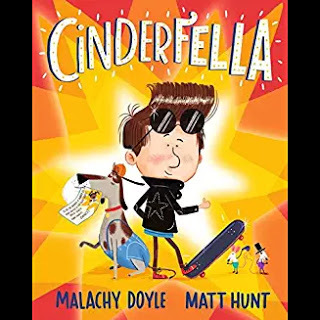
(c) Malachy Doyle and Matt Hunt (2018)
and who has written many picture books, including one of my favourite picture books
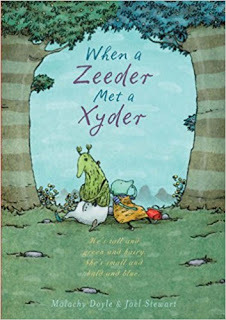 When a Zeeder Met a Xyder ( (c) Malachy Doyle and Joel Stewart, 2006)
When a Zeeder Met a Xyder ( (c) Malachy Doyle and Joel Stewart, 2006)
is not a planner either:
“I find that, when I write longer, it can be very time-consuming because I craft every sentence, sweat over every word, as I would when writing picture book. I haven't learnt to run loose. I like to work in miniature - poetry, picture book, Barrington Stoke length books for older readers. Somehow it just suits me. I never plan. Which may work better for picture book than full-length novel, but it's just how I work. Find a character, put them in an interesting situation and run with it. Surprise yourself!”
And what do you find are the advantages and disadvantages of staying with a story so long when you’re writing a novel as opposed to a picture book? Jacob:
“By the time a novel goes to print, I must have read its 60,000 words two dozen times. That’s like reading one very repetitive 1,440,000 word novel. I’m sick and tired of it, and I struggle to remember that readers will be coming to it fresh.
On the other hand, it’s an absolute joy to plant a little clue on page one of a book, and pay it off in the last chapter, or even another book. Plus, there’s room for characters to grow and change and surprise not just the reader but me as well. Picture book characters still need to go on journeys, but they’re much shorter (and, usually, much less nuanced) ones".
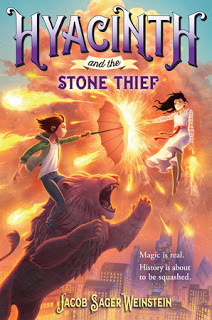
(c) Jacob Sager Weinstein (2018) Hyacinth and the Stone Thief -second in the trilogy (out in the US already)
Wendy:
“[with children's novels] I can start behaving like my characters. My children used to ask me to stop being ‘so Wendy Quillish’ when I was mid-series with her. (She’s always taking things too literally and getting into trouble). The dangers of method writing! [But the advantage?] When the writing is flowing, and the words are doing what they should, it feels amazing.
Also, I don’t think I do move on quickly [from picture books]. All the picture book characters I write stay with me. The process is very intense. Possibly more intense than novels. Rapunzel. The Glump. The Peeble. Stefano the Squid. All so very real in my head. Especially when an illustrator has helped bring them to life”.
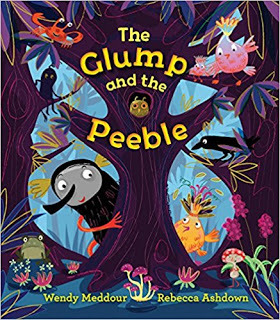
(c) Wendy Meddour and Rebecca Ashdown (2016)
Sophia?
“I get to know my characters so well [in a novel]. Also themes emerge as I write that I didn’t know would be important when I started, but which obviously mean a lot to me and bubble up from my subconscious as I go. Often, what the novel ends up being ‘about’ is not at all what I had in mind when I started. Threads is definitely about the power of friendship, for example, but I meant to write about the unknowability of genius and the other girls were just in it to do functional things in the plot. Then their personalities took over and the pleasure came from how they interacted.”
And which do you prefer, or find easier to write?Jacob:
“Picturebooks originally came more naturally to me. Before I turned to kids books, I had written short stories and screenplays for [adults]. Like a short story, a picture book is an intense narrative burst. Like a screenplay, a picture book text is just one part of a collaboration with a visual artist. So the skills I had spent years developing were much more applicable to PBs. Now that I’ve written two MG novels (and a few drafts of a third), I think I’ve finally got the hang of it, and I don’t think either form is easier than the other. I don’t have a preference, which is why I write both! I consider myself really lucky that I can work in both forms”.

A 'really lucky' Jacob Sager Weinstein
Wendy:
“I enjoy all forms of writing. They exercise different parts of my brain and allow me to explore ideas and play with thoughts in different ways… Adapting my style or tone of voice to suit the intended audience is all part of the fun. Rhyming picture books come very easily, as they have a certain silliness and structure, but if I can hear a character’s voice in my mind, then I’m off”.
Sophia:
“I find both difficult. The only books I have ever found easy were the very first one I wrote - an (unpublished) adult detective story, and book two of the Threads trilogy, when the characters just seemed to do whatever I needed them to without question. I think I enjoy writing picture books more though. Because every word counts, I can take pleasure in each one. I also love imagining what an illustrator will do. I want to write one for 5-7 year olds about Abstract Impressionism, so I don’t exactly set myself the easiest tasks, but I’ll be so pleased if I manage to make it work the way it does in my head”.
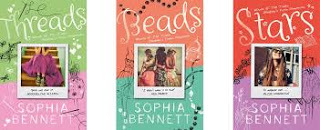
Beads, the only one of Sophia's published books that she found easy to write
And Malachy?
“Picture books are my first love. I find that when I go teenage - Georgie, Who is Jesse Flood? for example - I go all angsty. I find that I become the age I was then, in a strange way. I've decided that I much prefer to inhabit the young happy enquiring Malachy than the angst-ridden teen Malachy, so that's where I concentrate my efforts these days.
I also love working with illustrators, and my books becoming more than the sum of their parts - when an illustrator totally gets where I'm coming from in my story, but then adds the depth and wonder that they can bring as a gifted visual artist, true magic, a form of alchemy, can happen. My new picture book, Molly and the Stormy Sea, out this week from Graffeg, illustrated by the wonderful Andrew Whitson, is a perfect example of this”.
trailer for Molly and the Stormy Sea (c) Malachy Doyle and Andrew Whitson (2018)
I love picture books. I even found myself feeling guilty for choosing to write a (YA) novel when I’ve pledged my allegiance to picture books. But now I’m writing ‘up’ the novel (that is already planned and plotted), I’m back to continue with both. It may take many, many drafts (probably fewer than the 187 drafts Malachy had for his first picture book, and I hope fewer than the seventeen drafts Sophia did for her first published novel, Threads, before she was ready to send it off and then a further seventeen before it was finished and published, though very possibly not) but I’m ready to go with it. To accept that I’m going to learn a whole lot over the next couple of years about something new, that I’ll make a ton of mistakes along the way (like I encourage young people in schools to do, all the time), that I’ll probably feel the terror that I did when showing my picture book manuscripts back when I started, before I grew a very tough (picture book) skin. Will that toughness extend to showing people my novel? I suspect not, but I also suspect it won’t be quite as awful and raw as it was. And actually allowing yourself to be vulnerable like that is a pretty powerful thing:
Brene Brown's Ted Talk on vulnerability
I will do Jacob’s ‘picture book author’ edit on my novel where I try and cut lots of words that aren’t necessary. I am hopeful that writing this novel will also help me write early versions of picture books more quickly (if I wrote anything like as slowly with the novel, it would be many, many years before I got my first novel draft out). And that I’ll learn new things about structuring which will strengthen future picture books, too. Whatever the outcome, I will finish a first draft, and then a second, and subsequent ones, and I will learn loads –about story writing and myself. I hope that writing as a teenager won't make me get too angsty. Like Malachy, I was a much happier picture-book aged child than I was a teenager (so thanks for the warning, Malachy). And if it doesn’t end up as a published novel, well that’s not the end of the world. I will have gained much more than if I hadn’t tried (I've already read more novels in the past year than I probably had in the previous twenty). And who knows, it might even one day find itself a home…
Many thanks to Sophia Bennett, Malachy Doyle, Candy Gourlay, Wendy Meddour and Jacob Sager Weinstein for sharing their helpful thoughts on writing in both genres. If you've tried writing picture books and novels, how has the writing and planning of one type affected the writing and planning of the other? I'd love to hear from you with any thoughts, below. Juliet Clare Bell is the author of five picture books and three early readers. She would love to add the novel she is currently writing to this, but fully intends to write many more picture books, regardless.
www.julietclarebell.com

The joy of having your first book published and feeling like a 'real writer'. A young (non-panicking) Annika jumping for joy (on my behalf) at my first book, Don't Panic, Annika! (illustrated by Jennifer E Morris, 2011)
But what about when you feel legitimate in one area of writing but start doing something in a brand new one? Do you have to start again as a complete newbie? What strategies from one can you bring to the other? And can you keep some of that confidence, or do you have to go back to those terrible apologetic conversations with people about what you’re currently writing?
Well in the spirit of allowing yourself to be vulnerable and to take risks in order to be and know who you are (which is central to the story I’m writing), I’m ’fessing up, even though I’m at the early apologetic stage:
I AM WRITING A NOVEL.
I had to delete and change that from ‘I AM TRYING TO WRITE A NOVEL’, the language I’ve absolutely slipped back into now I’m writing in a completely new field. But I am writing one. It may never end up getting published, but I AM writing it, rather than ‘trying to write it’ and I am trying to use what I already know from writing picture books.
I love learning from other people, and so I asked a few children's writer-y friends who have done/are doing both children's novels and picture books, for their thoughts…
First, I wanted to know how easy is it to work on both at the same time?
I asked this because I have so far found it extremely difficult to think about both. It turns out, the writers I asked who liked writing both genres all found the switching easy. Here’s Sophia Bennett, successful, award-winning author of novels including Unveiling Venus, Threads and Love Song …. and who has at least one new picture book out in 2019 (she can't say too much about anything at the moment, but having read a draft of one of them, I can tell you that she is an exquisite picture book writer).

Sophia's most recent novel, Unveiling Venus (Stripes Publishing, 2018)
“Finding the time is extremely difficult. But when I do, I actually love skipping from one to the other, because each one uses different brain space and makes coming back to what I was doing before feel fresh, and a pleasure.”

(c) Jacob Sager Weinstein (2017)
Jacob Sager Weinstein is the author of The City of Secret Rivers (an absolute favourite with one of my children), for which he has been shortlisted for the Branford Boase award for most promising new author, and the upcoming picture book Lyric McKerrigan, Secret Librarian (illustrated by Vera Brosgol).

(c) Jacob Sager Weinstein and Vera Brosgol (2018)
He agrees with Sophia:
“In some ways, it’s easier than just working on one kind of book — if I’m not in the right frame of mind for one, I’m often in the right frame of mind for the other. God knows I still procrastinate, but at least I have the option of procrastinating productively”.
Productive procrastination? I look forward to that…
Wendy Meddour, author of many books, including the Wendy Quill series

(c) Wendy Meddour and Mina May (2013)

(c) Wendy Meddour and Duncan Beedie. Stefano the Squid, Hero of the Deep will be out with Little Tiger Press
and also finds the shift easy, and does it based on timing:
“I generally treat myself to writing picture books on weekends …and work on novels at night (after I’ve finished work and the kids are in bed)”.
I’m feeling more hopeful now. I had naively thought when I started that I could work on my novel from 6-7am each morning, and then do everything else (picture books, author visits, admin etc) during the rest of the time available and that I could make the switch easily. But unlike the authors, above, I found it almost impossible to think about picture books at all whilst I was in the really early stages of doing the novel. As a picture book writer, I think loads about structure as it’s so critical to a picture book. I knew that I know how to write; I knew I know how to structure a picture book, but what I didn’t know was whether I could structure a novel. And so I made myself work on the structure and get that sorted (including having a description of each scene) before I actually started writing out the story at all. There was no way I was going to embark on a full-length novel if I wasn’t sure I could complete it in a way that made sense (I had started an adult novel about 17 years ago but never got beyond Chapter 3 as I just didn’t have a structure for the whole thing, even though I had hundreds of pages of rough notes about the characters). This was before I’d written picture books, and now I’m used to plotting and I’ve seen how a longer story can crumble so quickly without decent foundations. And, taking to heart the sentiment of Seamus Heaney's wonderful poem (with apologies to him for the spurious connection of his poem to the subject of children's novel writing, as opposed to love -but it's a great poem, and reading, of) Scaffolding I would never embark on such an enormous story without feeling I’d got my scaffolding in order:
Seamus Heaney reading his poem, ScaffoldingAs Sophia says:
“ I do find each novel daunting… knowing I’m going to risk writing for a whole year about something readers may not connect with when it’s done. You never know. That aspect of novel writing seems mad. At least with a picture book it’s quicker!”
Exactly. That’s why it’s taken so long for me even to consider trying to write a novel again. And at least if you have the scaffolding there, you feel more confident that what will stand at the end of it will be solid. Ish. And now, having finished the structure for the first draft, it feels like I don’t have to hold it all in my head anymore; I can just write what I’m told to (by me), looking at each scene description and following its structure. As a picture book writer, this feels much more familiar –and safe- and I am now going to put my Wendy Meddour hat on and write the novel at certain specified times of the week, and picture books at others, and I have just in this last week got back into thinking about picture books again. (Unless I am in need of a bit of Jacob's productive procrastination (thank you, Jacob), in which case I might be really frivolous, and swap...).
So how do the picture-book-and-children's novel writers I spoke with use strategies for plotting and structuring one type of book for the other?
Sophia:
“I am a planner. With all my books - adult, young adult and picture books - I plan and research a lot before I start, and more as I go. Even so, the story moves off in directions I wasn’t quite expecting. With all of them, my core subject is something I’m passionate about, so I put a lot of myself into them.”

Sophia Bennett
And on using novel writing strategies for a picture book?
“I think of it in various acts! Even though I only have a few hundred words to play with, I have my opening section, the building action, the climax and the resolution. I try and use interesting dialogue. I research a lot, think hard about the characters and have it plotted out in my head before I start, but then let the poetry of the words lead me on as I write.
As I’m new to picture books I don’t really have strategies for it - just an endless learning process. Hopefully I’ll have something to bring from it to the other books eventually. It might be to do with how much you can leave unsaid and still get the message across. I keep finding that the more words I cut, the better it gets.”
Candy, your thoughts?
Candy Gourlay, award-winning author of Tall Story and Shine

(c) Candy Gourlay, 2010
whose first picture book, Is It a Mermaid? (illustrated by Francesca Chessa, Otter Barry Books, 2018) is just out

(c) Candy Gourlay and Francesca Chessa (2018)
and whose new novel, Bone Talk (David Fickling Books, 2018) will be out later this year, talked about writing picture books as an author of children's novels:
“because novel writing has a lot to do with structure, I find myself applying longer format structural rules to my picture book writing. Like putting a plot pivot at the very middle of a story. And thinking hard about context and set up to create a satisfying pay off. I do this a million times over the course of writing a novel … so I can chart a reader's emotional arc as they read the novel. But in picture books, you only get one shot at satisfying your reader”.

(c) Candy Gourlay (2018)
And Jacob?
“Plot is probably more important in a novel than in a picture book. A picture book can be purely about language or character or a single emotion; a novel needs a well-structured story to drive it forward. For better or for worse, my picture books are very plot-driven. I’m in awe of PBs that don’t have a traditional plot, and I have no idea how to write one. “When you’re writing a picture book, you have to think carefully about every single word. With a novel, it’s easier to let flabby language slide. My last major rewrite of a novel is always to read it through and cut out as many words as I possibly can. I’m only realising it now, as I answer this question, but that definitely involves looking at my novel with the eyes of a picture book writer.”
Wendy, on the other hand, is not a natural planner:
“I’m not a good planner. I wish I was. But I’m not. I just love to write. This is true for both my picture books and novels. It’s the idea that is crucial. I never know exactly where I’m going to find myself. I just trust that some part of my brain does.
With both novels and picture books, an idea starts fizzing, one that I can’t ignore, so I write it out furiously. Then edit. And edit. And edit. Ideas often emerge when I’m trying to process an experience in real life: say, a worry about someone or something, or a topic I feel strongly about at the time: child refugees, migration, Islamophobia, childhood anxiety, library closures, sexism. Whatever. Writing it out (in fictional form) allows me to feel like I’m doing something productive. As to strategies, having always been an avid reader, I’m very familiar with both genres, so although it feels like a ‘natural process’ when I’m writing, and I’m not a planner as such, I think I am probably quite technical in my writing without being particularly conscious of it. I’ve read so many novels and picture books over the years that I know how to structure them, hook the reader and vary the pace. I also teach creative writing at Exeter University, so am used to giving lectures about ‘character’, ‘style’ and ‘form’”.
Malachy Doyle, whose picture book Cinderfella (illustrated by Matt Hunt) is coming out later this year with Walker,

(c) Malachy Doyle and Matt Hunt (2018)
and who has written many picture books, including one of my favourite picture books
 When a Zeeder Met a Xyder ( (c) Malachy Doyle and Joel Stewart, 2006)
When a Zeeder Met a Xyder ( (c) Malachy Doyle and Joel Stewart, 2006)is not a planner either:
“I find that, when I write longer, it can be very time-consuming because I craft every sentence, sweat over every word, as I would when writing picture book. I haven't learnt to run loose. I like to work in miniature - poetry, picture book, Barrington Stoke length books for older readers. Somehow it just suits me. I never plan. Which may work better for picture book than full-length novel, but it's just how I work. Find a character, put them in an interesting situation and run with it. Surprise yourself!”
And what do you find are the advantages and disadvantages of staying with a story so long when you’re writing a novel as opposed to a picture book? Jacob:
“By the time a novel goes to print, I must have read its 60,000 words two dozen times. That’s like reading one very repetitive 1,440,000 word novel. I’m sick and tired of it, and I struggle to remember that readers will be coming to it fresh.
On the other hand, it’s an absolute joy to plant a little clue on page one of a book, and pay it off in the last chapter, or even another book. Plus, there’s room for characters to grow and change and surprise not just the reader but me as well. Picture book characters still need to go on journeys, but they’re much shorter (and, usually, much less nuanced) ones".

(c) Jacob Sager Weinstein (2018) Hyacinth and the Stone Thief -second in the trilogy (out in the US already)
Wendy:
“[with children's novels] I can start behaving like my characters. My children used to ask me to stop being ‘so Wendy Quillish’ when I was mid-series with her. (She’s always taking things too literally and getting into trouble). The dangers of method writing! [But the advantage?] When the writing is flowing, and the words are doing what they should, it feels amazing.
Also, I don’t think I do move on quickly [from picture books]. All the picture book characters I write stay with me. The process is very intense. Possibly more intense than novels. Rapunzel. The Glump. The Peeble. Stefano the Squid. All so very real in my head. Especially when an illustrator has helped bring them to life”.

(c) Wendy Meddour and Rebecca Ashdown (2016)
Sophia?
“I get to know my characters so well [in a novel]. Also themes emerge as I write that I didn’t know would be important when I started, but which obviously mean a lot to me and bubble up from my subconscious as I go. Often, what the novel ends up being ‘about’ is not at all what I had in mind when I started. Threads is definitely about the power of friendship, for example, but I meant to write about the unknowability of genius and the other girls were just in it to do functional things in the plot. Then their personalities took over and the pleasure came from how they interacted.”
And which do you prefer, or find easier to write?Jacob:
“Picturebooks originally came more naturally to me. Before I turned to kids books, I had written short stories and screenplays for [adults]. Like a short story, a picture book is an intense narrative burst. Like a screenplay, a picture book text is just one part of a collaboration with a visual artist. So the skills I had spent years developing were much more applicable to PBs. Now that I’ve written two MG novels (and a few drafts of a third), I think I’ve finally got the hang of it, and I don’t think either form is easier than the other. I don’t have a preference, which is why I write both! I consider myself really lucky that I can work in both forms”.

A 'really lucky' Jacob Sager Weinstein
Wendy:
“I enjoy all forms of writing. They exercise different parts of my brain and allow me to explore ideas and play with thoughts in different ways… Adapting my style or tone of voice to suit the intended audience is all part of the fun. Rhyming picture books come very easily, as they have a certain silliness and structure, but if I can hear a character’s voice in my mind, then I’m off”.
Sophia:
“I find both difficult. The only books I have ever found easy were the very first one I wrote - an (unpublished) adult detective story, and book two of the Threads trilogy, when the characters just seemed to do whatever I needed them to without question. I think I enjoy writing picture books more though. Because every word counts, I can take pleasure in each one. I also love imagining what an illustrator will do. I want to write one for 5-7 year olds about Abstract Impressionism, so I don’t exactly set myself the easiest tasks, but I’ll be so pleased if I manage to make it work the way it does in my head”.

Beads, the only one of Sophia's published books that she found easy to write
And Malachy?
“Picture books are my first love. I find that when I go teenage - Georgie, Who is Jesse Flood? for example - I go all angsty. I find that I become the age I was then, in a strange way. I've decided that I much prefer to inhabit the young happy enquiring Malachy than the angst-ridden teen Malachy, so that's where I concentrate my efforts these days.
I also love working with illustrators, and my books becoming more than the sum of their parts - when an illustrator totally gets where I'm coming from in my story, but then adds the depth and wonder that they can bring as a gifted visual artist, true magic, a form of alchemy, can happen. My new picture book, Molly and the Stormy Sea, out this week from Graffeg, illustrated by the wonderful Andrew Whitson, is a perfect example of this”.
trailer for Molly and the Stormy Sea (c) Malachy Doyle and Andrew Whitson (2018)
I love picture books. I even found myself feeling guilty for choosing to write a (YA) novel when I’ve pledged my allegiance to picture books. But now I’m writing ‘up’ the novel (that is already planned and plotted), I’m back to continue with both. It may take many, many drafts (probably fewer than the 187 drafts Malachy had for his first picture book, and I hope fewer than the seventeen drafts Sophia did for her first published novel, Threads, before she was ready to send it off and then a further seventeen before it was finished and published, though very possibly not) but I’m ready to go with it. To accept that I’m going to learn a whole lot over the next couple of years about something new, that I’ll make a ton of mistakes along the way (like I encourage young people in schools to do, all the time), that I’ll probably feel the terror that I did when showing my picture book manuscripts back when I started, before I grew a very tough (picture book) skin. Will that toughness extend to showing people my novel? I suspect not, but I also suspect it won’t be quite as awful and raw as it was. And actually allowing yourself to be vulnerable like that is a pretty powerful thing:
Brene Brown's Ted Talk on vulnerability
I will do Jacob’s ‘picture book author’ edit on my novel where I try and cut lots of words that aren’t necessary. I am hopeful that writing this novel will also help me write early versions of picture books more quickly (if I wrote anything like as slowly with the novel, it would be many, many years before I got my first novel draft out). And that I’ll learn new things about structuring which will strengthen future picture books, too. Whatever the outcome, I will finish a first draft, and then a second, and subsequent ones, and I will learn loads –about story writing and myself. I hope that writing as a teenager won't make me get too angsty. Like Malachy, I was a much happier picture-book aged child than I was a teenager (so thanks for the warning, Malachy). And if it doesn’t end up as a published novel, well that’s not the end of the world. I will have gained much more than if I hadn’t tried (I've already read more novels in the past year than I probably had in the previous twenty). And who knows, it might even one day find itself a home…
Many thanks to Sophia Bennett, Malachy Doyle, Candy Gourlay, Wendy Meddour and Jacob Sager Weinstein for sharing their helpful thoughts on writing in both genres. If you've tried writing picture books and novels, how has the writing and planning of one type affected the writing and planning of the other? I'd love to hear from you with any thoughts, below. Juliet Clare Bell is the author of five picture books and three early readers. She would love to add the novel she is currently writing to this, but fully intends to write many more picture books, regardless.
www.julietclarebell.com
Published on June 17, 2018 23:00
June 10, 2018
Why I Paint • Garry Parsons
It’s often difficult to work out just how illustrators go about making their artwork for picture books without asking them directly and really, the not knowing adds to the mystery anyway? But, being an illustrator myself, it’s something I like to ponder over and look closely at when I fall in love with a spread from a new picture book from a talented illustrator.
I might study the illustrations to consider “How did they get that texture?” Or “What did they do to make that depth so convincing or compelling?” for example.
What I do know is that most illustrators working today deliver their final art electronically. Delivering artwork as a finished piece is apparently becoming a rarity. I know this because of the reactions I receive from publishers when I hand over my painted picture book boards. It’s not that they receive my artwork with a sour expression, far from it, what I get is often delighted gasps along with a few “oohs” and “aahs”.
Don’t get me wrong, I’m a fan of the oohs and aahs, but they can be accompanied by comments exclaiming how “hardly anyone delivers art this way any more” and just how “rare” it is to handle original artworks that need to be sent for scanning. It’s the “rarity” aspect that has prompted me to write, because, I realise, I’m not only painting dinosaurs, I am one!
 From The Dinosaurs Are Having A Party! Gareth P Jones & Garry Parsons
From The Dinosaurs Are Having A Party! Gareth P Jones & Garry Parsons
My art school training was as a painter on a fine art degree course back in the 90’s. British painters where prominent in the art scene at the time and the art schools reflected that appeal in what they offered to students embarking on fine art careers, those being painting, sculpture or printmaking.
 Sandwagon. Garry Parsons. 1990The well-known painters of the day used paint in such a way that brush strokes, daubs and drips were plainly visible. I relished the bold brushwork and fluid expression of paint and found myself greatly influenced by the contemporaries of the day, especially those who were figurative and those who included animal motifs in their work. I looked closely at the works of Ken Kiff, Paula Rego, Philip Guston and Eileen Cooper, to name a few.
Sandwagon. Garry Parsons. 1990The well-known painters of the day used paint in such a way that brush strokes, daubs and drips were plainly visible. I relished the bold brushwork and fluid expression of paint and found myself greatly influenced by the contemporaries of the day, especially those who were figurative and those who included animal motifs in their work. I looked closely at the works of Ken Kiff, Paula Rego, Philip Guston and Eileen Cooper, to name a few.
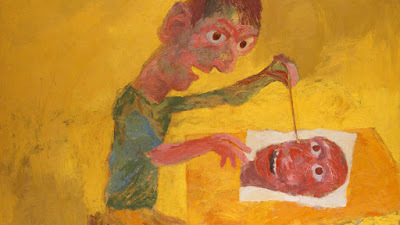 Ken Kiff. Man Painting on Yellow. 1965
Ken Kiff. Man Painting on Yellow. 1965
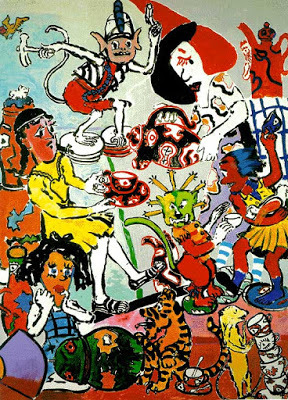 Paula Rego. The Vivian Girls With The China. 1984
Paula Rego. The Vivian Girls With The China. 1984
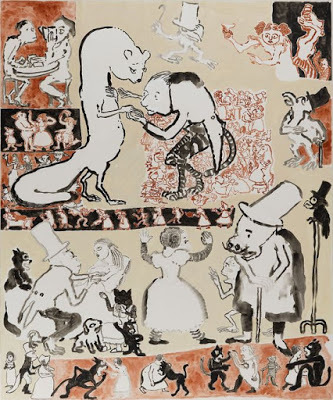 Paula Rego. La Traviata. 1983
Paula Rego. La Traviata. 1983
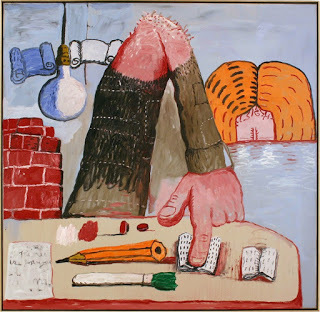 Philip Guston. The Rest Is For You. 1972
Philip Guston. The Rest Is For You. 1972
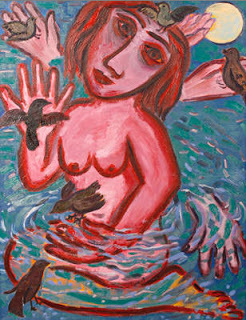 Eileen Cooper. Woman Bathing in Her Own Tears. 1987I also liked to think that I employed a loose narrative in my paintings, which connected them together. It wasn’t until much later that I realized that the work I was producing was like a giant wall-sized picture book and that, with a reduction in scale, it might become a book. So, with this in mind, along with a few years in the desperate wilderness of becoming a painter (I sold one painting in two years!), I went back to Brighton to study on the Sequential Design MA under George Hardie and John Vernon-Lord.
Eileen Cooper. Woman Bathing in Her Own Tears. 1987I also liked to think that I employed a loose narrative in my paintings, which connected them together. It wasn’t until much later that I realized that the work I was producing was like a giant wall-sized picture book and that, with a reduction in scale, it might become a book. So, with this in mind, along with a few years in the desperate wilderness of becoming a painter (I sold one painting in two years!), I went back to Brighton to study on the Sequential Design MA under George Hardie and John Vernon-Lord.
 John Vernon-Lord. The Giant Jam Sandwich. Verses by Janet Burroway. Jonathan Cape 1972
John Vernon-Lord. The Giant Jam Sandwich. Verses by Janet Burroway. Jonathan Cape 1972
I altered the scale of my work but continued to paint with the notion of moving towards animation and illustration. I made a monochrome book based on the opera “A Woman Without A Shadow” by Richard Strauss, a rather sinister tale about unborn children and fried fish. In my second year, and in need of a lighter subject to work on, I embarked on a short animated film depicting the life of Pythagoras, in which collaged numbers floated skyward from a very loosely painted main character, who preached to animals about numeracy. On leaving the MA, I started illustrating for editorial, my painted images appearing in Sunday supplements, newspapers and magazines, with some advertising jobs thrown in. Illustration was at an all-time high of popularity with public media, and illustration catalogues were fat with illustrators taking a share of the feast.
So, despite exploring and learning new graphics technologies, I continued to paint, but in a style that was more akin to children’s publishing, leading to my first publishing commissions: “Digging for Dinosaurs” by Judy Waite and then “Billy’s Bucket” by Kes Grey, first published in 2004.
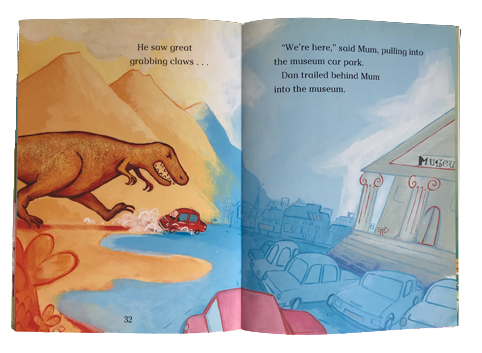 Digging For Dinosaurs. Judy Waite & Garry Parsons. Red Fox
Digging For Dinosaurs. Judy Waite & Garry Parsons. Red Fox
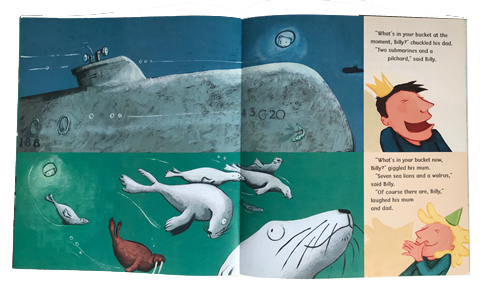 Billy's Bucket. Kes Grey & Garry Parsons. Bodley Head
Billy's Bucket. Kes Grey & Garry Parsons. Bodley Head
I remember enjoying the drawn, painted and multi-media approaches of Cathy Gale, Sara Fanelli and John Burningham at this time.
 Cathy Gale. All Your Own Teeth. Written by Adrienne Geoghegan. Bloomsbury
Cathy Gale. All Your Own Teeth. Written by Adrienne Geoghegan. Bloomsbury
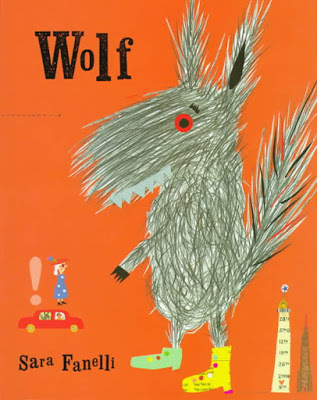 Sara Fanelli. Wolf. Mammoth 1997
Sara Fanelli. Wolf. Mammoth 1997
 John Burningham. Oi, Get Off Our Train!. Red Fox 1991As far as I could tell, every illustrator would have been hand delivering finished original artwork to his or her publisher to be sent to the Far East to be scanned and reproduced. Once the artwork was given to your editor, the next time you saw it was in a finished book, at least it was in my case.
John Burningham. Oi, Get Off Our Train!. Red Fox 1991As far as I could tell, every illustrator would have been hand delivering finished original artwork to his or her publisher to be sent to the Far East to be scanned and reproduced. Once the artwork was given to your editor, the next time you saw it was in a finished book, at least it was in my case.
Somewhere over the years my editorial work switched entirely to a digital format and this has more recently included some publishing work too, but painting has continued as a steady staple within my picture book illustration and the enjoyment of using paint as my main medium remains. I find great pleasure in the handling of acrylics, from the mixing of colour to it’s rough initial application through the slow development from splurges and daubs to something more refined. When I hold up original artwork to a class of year 2 students I’m often questioned about their authenticity, “are you sure they are not print-outs? Or, did you really use a brush on that?”
 Garry Parsons.
Garry Parsons.
It's no longer the case that once the artwork is given to the publisher the next time I see it is in book form. I am increasingly working into the painted artwork digitally, it might be to add texture to a dinosaurs skin, a pattern on a piece of clothing or just a sparkle to the surface of water.
What I’m learning to embrace now is the novelty of being a dinosaur delivering painted artwork about dinosaurs.
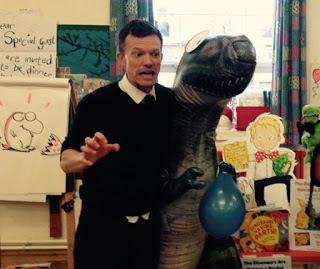
***
You can see more of Garry's illustration for children's books on his website by clicking here. Follow on twitter @icandrawdinos
I might study the illustrations to consider “How did they get that texture?” Or “What did they do to make that depth so convincing or compelling?” for example.
What I do know is that most illustrators working today deliver their final art electronically. Delivering artwork as a finished piece is apparently becoming a rarity. I know this because of the reactions I receive from publishers when I hand over my painted picture book boards. It’s not that they receive my artwork with a sour expression, far from it, what I get is often delighted gasps along with a few “oohs” and “aahs”.
Don’t get me wrong, I’m a fan of the oohs and aahs, but they can be accompanied by comments exclaiming how “hardly anyone delivers art this way any more” and just how “rare” it is to handle original artworks that need to be sent for scanning. It’s the “rarity” aspect that has prompted me to write, because, I realise, I’m not only painting dinosaurs, I am one!
 From The Dinosaurs Are Having A Party! Gareth P Jones & Garry Parsons
From The Dinosaurs Are Having A Party! Gareth P Jones & Garry ParsonsMy art school training was as a painter on a fine art degree course back in the 90’s. British painters where prominent in the art scene at the time and the art schools reflected that appeal in what they offered to students embarking on fine art careers, those being painting, sculpture or printmaking.
 Sandwagon. Garry Parsons. 1990The well-known painters of the day used paint in such a way that brush strokes, daubs and drips were plainly visible. I relished the bold brushwork and fluid expression of paint and found myself greatly influenced by the contemporaries of the day, especially those who were figurative and those who included animal motifs in their work. I looked closely at the works of Ken Kiff, Paula Rego, Philip Guston and Eileen Cooper, to name a few.
Sandwagon. Garry Parsons. 1990The well-known painters of the day used paint in such a way that brush strokes, daubs and drips were plainly visible. I relished the bold brushwork and fluid expression of paint and found myself greatly influenced by the contemporaries of the day, especially those who were figurative and those who included animal motifs in their work. I looked closely at the works of Ken Kiff, Paula Rego, Philip Guston and Eileen Cooper, to name a few.  Ken Kiff. Man Painting on Yellow. 1965
Ken Kiff. Man Painting on Yellow. 1965 Paula Rego. The Vivian Girls With The China. 1984
Paula Rego. The Vivian Girls With The China. 1984
 Paula Rego. La Traviata. 1983
Paula Rego. La Traviata. 1983
 Philip Guston. The Rest Is For You. 1972
Philip Guston. The Rest Is For You. 1972 Eileen Cooper. Woman Bathing in Her Own Tears. 1987I also liked to think that I employed a loose narrative in my paintings, which connected them together. It wasn’t until much later that I realized that the work I was producing was like a giant wall-sized picture book and that, with a reduction in scale, it might become a book. So, with this in mind, along with a few years in the desperate wilderness of becoming a painter (I sold one painting in two years!), I went back to Brighton to study on the Sequential Design MA under George Hardie and John Vernon-Lord.
Eileen Cooper. Woman Bathing in Her Own Tears. 1987I also liked to think that I employed a loose narrative in my paintings, which connected them together. It wasn’t until much later that I realized that the work I was producing was like a giant wall-sized picture book and that, with a reduction in scale, it might become a book. So, with this in mind, along with a few years in the desperate wilderness of becoming a painter (I sold one painting in two years!), I went back to Brighton to study on the Sequential Design MA under George Hardie and John Vernon-Lord. John Vernon-Lord. The Giant Jam Sandwich. Verses by Janet Burroway. Jonathan Cape 1972
John Vernon-Lord. The Giant Jam Sandwich. Verses by Janet Burroway. Jonathan Cape 1972I altered the scale of my work but continued to paint with the notion of moving towards animation and illustration. I made a monochrome book based on the opera “A Woman Without A Shadow” by Richard Strauss, a rather sinister tale about unborn children and fried fish. In my second year, and in need of a lighter subject to work on, I embarked on a short animated film depicting the life of Pythagoras, in which collaged numbers floated skyward from a very loosely painted main character, who preached to animals about numeracy. On leaving the MA, I started illustrating for editorial, my painted images appearing in Sunday supplements, newspapers and magazines, with some advertising jobs thrown in. Illustration was at an all-time high of popularity with public media, and illustration catalogues were fat with illustrators taking a share of the feast.
So, despite exploring and learning new graphics technologies, I continued to paint, but in a style that was more akin to children’s publishing, leading to my first publishing commissions: “Digging for Dinosaurs” by Judy Waite and then “Billy’s Bucket” by Kes Grey, first published in 2004.
 Digging For Dinosaurs. Judy Waite & Garry Parsons. Red Fox
Digging For Dinosaurs. Judy Waite & Garry Parsons. Red Fox Billy's Bucket. Kes Grey & Garry Parsons. Bodley Head
Billy's Bucket. Kes Grey & Garry Parsons. Bodley HeadI remember enjoying the drawn, painted and multi-media approaches of Cathy Gale, Sara Fanelli and John Burningham at this time.
 Cathy Gale. All Your Own Teeth. Written by Adrienne Geoghegan. Bloomsbury
Cathy Gale. All Your Own Teeth. Written by Adrienne Geoghegan. Bloomsbury
 Sara Fanelli. Wolf. Mammoth 1997
Sara Fanelli. Wolf. Mammoth 1997
 John Burningham. Oi, Get Off Our Train!. Red Fox 1991As far as I could tell, every illustrator would have been hand delivering finished original artwork to his or her publisher to be sent to the Far East to be scanned and reproduced. Once the artwork was given to your editor, the next time you saw it was in a finished book, at least it was in my case.
John Burningham. Oi, Get Off Our Train!. Red Fox 1991As far as I could tell, every illustrator would have been hand delivering finished original artwork to his or her publisher to be sent to the Far East to be scanned and reproduced. Once the artwork was given to your editor, the next time you saw it was in a finished book, at least it was in my case.Somewhere over the years my editorial work switched entirely to a digital format and this has more recently included some publishing work too, but painting has continued as a steady staple within my picture book illustration and the enjoyment of using paint as my main medium remains. I find great pleasure in the handling of acrylics, from the mixing of colour to it’s rough initial application through the slow development from splurges and daubs to something more refined. When I hold up original artwork to a class of year 2 students I’m often questioned about their authenticity, “are you sure they are not print-outs? Or, did you really use a brush on that?”
 Garry Parsons.
Garry Parsons.It's no longer the case that once the artwork is given to the publisher the next time I see it is in book form. I am increasingly working into the painted artwork digitally, it might be to add texture to a dinosaurs skin, a pattern on a piece of clothing or just a sparkle to the surface of water.
What I’m learning to embrace now is the novelty of being a dinosaur delivering painted artwork about dinosaurs.

***
You can see more of Garry's illustration for children's books on his website by clicking here. Follow on twitter @icandrawdinos
Published on June 10, 2018 16:46
Why I Paint
It’s often difficult to work out just how illustrators go about making their artwork for picture books without asking them directly and really, the not knowing adds to the mystery anyway? But, being an illustrator myself, it’s something I like to ponder over and look closely at when I fall in love with a spread from a new picture book from a talented illustrator.
I might study the illustrations to consider “How did they get that texture?” Or “What did they do to make that depth so convincing or compelling?” for example.
What I do know is that most illustrators working today deliver their final art electronically. Delivering artwork as a finished piece is apparently becoming a rarity. I know this because of the reactions I receive from publishers when I hand over my painted picture book boards. It’s not that they receive my artwork with a sour expression, far from it, what I get is often delighted gasps along with a few “oohs” and “aahs”.
Don’t get me wrong, I’m a fan of the oohs and aahs, but they can be accompanied by comments exclaiming how “hardly anyone delivers art this way any more” and just how “rare” it is to handle original artworks that need to be sent for scanning. It’s the “rarity” aspect that has prompted me to write, because, I realise, I’m not only painting dinosaurs, I am one!
 From The Dinosaurs Are Having A Party! Gareth P Jones & Garry Parsons
From The Dinosaurs Are Having A Party! Gareth P Jones & Garry Parsons
My art school training was as a painter on a fine art degree course back in the 90’s. British painters where prominent in the art scene at the time and the art schools reflected that appeal in what they offered to students embarking on fine art careers, those being painting, sculpture or printmaking.
 Sandwagon. Garry Parsons. 1990The well-known painters of the day used paint in such a way that brush strokes, daubs and drips were plainly visible. I relished the bold brushwork and fluid expression of paint and found myself greatly influenced by the contemporaries of the day, especially those who were figurative and those who included animal motifs in their work. I looked closely at the works of Ken Kiff, Paula Rego, Philip Guston and Eileen Cooper, to name a few.
Sandwagon. Garry Parsons. 1990The well-known painters of the day used paint in such a way that brush strokes, daubs and drips were plainly visible. I relished the bold brushwork and fluid expression of paint and found myself greatly influenced by the contemporaries of the day, especially those who were figurative and those who included animal motifs in their work. I looked closely at the works of Ken Kiff, Paula Rego, Philip Guston and Eileen Cooper, to name a few.
 Ken Kiff. Man Painting on Yellow. 1965
Ken Kiff. Man Painting on Yellow. 1965
 Paula Rego. The Vivian Girls With The China. 1984
Paula Rego. The Vivian Girls With The China. 1984
 Paula Rego. La Traviata. 1983
Paula Rego. La Traviata. 1983
 Philip Guston. The Rest Is For You. 1972
Philip Guston. The Rest Is For You. 1972
 Eileen Cooper. Woman Bathing in Her Own Tears. 1987I also liked to think that I employed a loose narrative in my paintings, which connected them together. It wasn’t until much later that I realized that the work I was producing was like a giant wall-sized picture book and that, with a reduction in scale, it might become a book. So, with this in mind, along with a few years in the desperate wilderness of becoming a painter (I sold one painting in two years!), I went back to Brighton to study on the Sequential Design MA under George Hardie and John Vernon-Lord.
Eileen Cooper. Woman Bathing in Her Own Tears. 1987I also liked to think that I employed a loose narrative in my paintings, which connected them together. It wasn’t until much later that I realized that the work I was producing was like a giant wall-sized picture book and that, with a reduction in scale, it might become a book. So, with this in mind, along with a few years in the desperate wilderness of becoming a painter (I sold one painting in two years!), I went back to Brighton to study on the Sequential Design MA under George Hardie and John Vernon-Lord.
 John Vernon-Lord. The Giant Jam Sandwich. Verses by Janet Burroway. Jonathan Cape 1972
John Vernon-Lord. The Giant Jam Sandwich. Verses by Janet Burroway. Jonathan Cape 1972
I altered the scale of my work but continued to paint with the notion of moving towards animation and illustration. I made a monochrome book based on the opera “A Woman Without A Shadow” by Richard Strauss, a rather sinister tale about unborn children and fried fish. In my second year, and in need of a lighter subject to work on, I embarked on a short animated film depicting the life of Pythagoras, in which collaged numbers floated skyward from a very loosely painted main character, who preached to animals about numeracy. On leaving the MA, I started illustrating for editorial, my painted images appearing in Sunday supplements, newspapers and magazines, with some advertising jobs thrown in. Illustration was at an all-time high of popularity with public media, and illustration catalogues were fat with illustrators taking a share of the feast.
So, despite exploring and learning new graphics technologies, I continued to paint, but in a style that was more akin to children’s publishing, leading to my first publishing commissions: “Digging for Dinosaurs” by Judy Waite and then “Billy’s Bucket” by Kes Grey, first published in 2004.
 Digging For Dinosaurs. Judy Waite & Garry Parsons. Red Fox
Digging For Dinosaurs. Judy Waite & Garry Parsons. Red Fox
 Billy's Bucket. Kes Grey & Garry Parsons. Bodley Head
Billy's Bucket. Kes Grey & Garry Parsons. Bodley Head
I remember enjoying the drawn, painted and multi-media approaches of Cathy Gale, Sara Fanelli and John Burningham at this time.
 Cathy Gale. All Your Own Teeth. Written by Adrienne Geoghegan. Bloomsbury
Cathy Gale. All Your Own Teeth. Written by Adrienne Geoghegan. Bloomsbury
 Sara Fanelli. Wolf. Mammoth 1997
Sara Fanelli. Wolf. Mammoth 1997
 John Burningham. Oi, Get Off Our Train!. Red Fox 1991As far as I could tell, every illustrator would have been hand delivering finished original artwork to his or her publisher to be sent to the Far East to be scanned and reproduced. Once the artwork was given to your editor, the next time you saw it was in a finished book, at least it was in my case.
John Burningham. Oi, Get Off Our Train!. Red Fox 1991As far as I could tell, every illustrator would have been hand delivering finished original artwork to his or her publisher to be sent to the Far East to be scanned and reproduced. Once the artwork was given to your editor, the next time you saw it was in a finished book, at least it was in my case.
Somewhere over the years my editorial work switched entirely to a digital format and this has more recently included some publishing work too, but painting has continued as a steady staple within my picture book illustration and the enjoyment of using paint as my main medium remains. I find great pleasure in the handling of acrylics, from the mixing of colour to it’s rough initial application through the slow development from splurges and daubs to something more refined. When I hold up original artwork to a class of year 2 students I’m often questioned about their authenticity, “are you sure they are not print-outs? Or, did you really use a brush on that?”
 Garry Parsons.
Garry Parsons.
It's no longer the case that once the artwork is given to the publishing the next time I see it is in book form. I am increasingly working into the painted artwork digitally, it might be to add texture to a dinosaurs skin, a pattern on a piece of clothing or just a sparkle to the surface of water.
What I’m learning to embrace now is the novelty of being a dinosaur delivering painted artwork about dinosaurs.

***
You can see more of Garry's illustration for children's books on his website by clicking here. Follow on twitter @icandrawdinos
I might study the illustrations to consider “How did they get that texture?” Or “What did they do to make that depth so convincing or compelling?” for example.
What I do know is that most illustrators working today deliver their final art electronically. Delivering artwork as a finished piece is apparently becoming a rarity. I know this because of the reactions I receive from publishers when I hand over my painted picture book boards. It’s not that they receive my artwork with a sour expression, far from it, what I get is often delighted gasps along with a few “oohs” and “aahs”.
Don’t get me wrong, I’m a fan of the oohs and aahs, but they can be accompanied by comments exclaiming how “hardly anyone delivers art this way any more” and just how “rare” it is to handle original artworks that need to be sent for scanning. It’s the “rarity” aspect that has prompted me to write, because, I realise, I’m not only painting dinosaurs, I am one!
 From The Dinosaurs Are Having A Party! Gareth P Jones & Garry Parsons
From The Dinosaurs Are Having A Party! Gareth P Jones & Garry ParsonsMy art school training was as a painter on a fine art degree course back in the 90’s. British painters where prominent in the art scene at the time and the art schools reflected that appeal in what they offered to students embarking on fine art careers, those being painting, sculpture or printmaking.
 Sandwagon. Garry Parsons. 1990The well-known painters of the day used paint in such a way that brush strokes, daubs and drips were plainly visible. I relished the bold brushwork and fluid expression of paint and found myself greatly influenced by the contemporaries of the day, especially those who were figurative and those who included animal motifs in their work. I looked closely at the works of Ken Kiff, Paula Rego, Philip Guston and Eileen Cooper, to name a few.
Sandwagon. Garry Parsons. 1990The well-known painters of the day used paint in such a way that brush strokes, daubs and drips were plainly visible. I relished the bold brushwork and fluid expression of paint and found myself greatly influenced by the contemporaries of the day, especially those who were figurative and those who included animal motifs in their work. I looked closely at the works of Ken Kiff, Paula Rego, Philip Guston and Eileen Cooper, to name a few.  Ken Kiff. Man Painting on Yellow. 1965
Ken Kiff. Man Painting on Yellow. 1965 Paula Rego. The Vivian Girls With The China. 1984
Paula Rego. The Vivian Girls With The China. 1984
 Paula Rego. La Traviata. 1983
Paula Rego. La Traviata. 1983
 Philip Guston. The Rest Is For You. 1972
Philip Guston. The Rest Is For You. 1972 Eileen Cooper. Woman Bathing in Her Own Tears. 1987I also liked to think that I employed a loose narrative in my paintings, which connected them together. It wasn’t until much later that I realized that the work I was producing was like a giant wall-sized picture book and that, with a reduction in scale, it might become a book. So, with this in mind, along with a few years in the desperate wilderness of becoming a painter (I sold one painting in two years!), I went back to Brighton to study on the Sequential Design MA under George Hardie and John Vernon-Lord.
Eileen Cooper. Woman Bathing in Her Own Tears. 1987I also liked to think that I employed a loose narrative in my paintings, which connected them together. It wasn’t until much later that I realized that the work I was producing was like a giant wall-sized picture book and that, with a reduction in scale, it might become a book. So, with this in mind, along with a few years in the desperate wilderness of becoming a painter (I sold one painting in two years!), I went back to Brighton to study on the Sequential Design MA under George Hardie and John Vernon-Lord. John Vernon-Lord. The Giant Jam Sandwich. Verses by Janet Burroway. Jonathan Cape 1972
John Vernon-Lord. The Giant Jam Sandwich. Verses by Janet Burroway. Jonathan Cape 1972I altered the scale of my work but continued to paint with the notion of moving towards animation and illustration. I made a monochrome book based on the opera “A Woman Without A Shadow” by Richard Strauss, a rather sinister tale about unborn children and fried fish. In my second year, and in need of a lighter subject to work on, I embarked on a short animated film depicting the life of Pythagoras, in which collaged numbers floated skyward from a very loosely painted main character, who preached to animals about numeracy. On leaving the MA, I started illustrating for editorial, my painted images appearing in Sunday supplements, newspapers and magazines, with some advertising jobs thrown in. Illustration was at an all-time high of popularity with public media, and illustration catalogues were fat with illustrators taking a share of the feast.
So, despite exploring and learning new graphics technologies, I continued to paint, but in a style that was more akin to children’s publishing, leading to my first publishing commissions: “Digging for Dinosaurs” by Judy Waite and then “Billy’s Bucket” by Kes Grey, first published in 2004.
 Digging For Dinosaurs. Judy Waite & Garry Parsons. Red Fox
Digging For Dinosaurs. Judy Waite & Garry Parsons. Red Fox Billy's Bucket. Kes Grey & Garry Parsons. Bodley Head
Billy's Bucket. Kes Grey & Garry Parsons. Bodley HeadI remember enjoying the drawn, painted and multi-media approaches of Cathy Gale, Sara Fanelli and John Burningham at this time.
 Cathy Gale. All Your Own Teeth. Written by Adrienne Geoghegan. Bloomsbury
Cathy Gale. All Your Own Teeth. Written by Adrienne Geoghegan. Bloomsbury
 Sara Fanelli. Wolf. Mammoth 1997
Sara Fanelli. Wolf. Mammoth 1997
 John Burningham. Oi, Get Off Our Train!. Red Fox 1991As far as I could tell, every illustrator would have been hand delivering finished original artwork to his or her publisher to be sent to the Far East to be scanned and reproduced. Once the artwork was given to your editor, the next time you saw it was in a finished book, at least it was in my case.
John Burningham. Oi, Get Off Our Train!. Red Fox 1991As far as I could tell, every illustrator would have been hand delivering finished original artwork to his or her publisher to be sent to the Far East to be scanned and reproduced. Once the artwork was given to your editor, the next time you saw it was in a finished book, at least it was in my case.Somewhere over the years my editorial work switched entirely to a digital format and this has more recently included some publishing work too, but painting has continued as a steady staple within my picture book illustration and the enjoyment of using paint as my main medium remains. I find great pleasure in the handling of acrylics, from the mixing of colour to it’s rough initial application through the slow development from splurges and daubs to something more refined. When I hold up original artwork to a class of year 2 students I’m often questioned about their authenticity, “are you sure they are not print-outs? Or, did you really use a brush on that?”
 Garry Parsons.
Garry Parsons.It's no longer the case that once the artwork is given to the publishing the next time I see it is in book form. I am increasingly working into the painted artwork digitally, it might be to add texture to a dinosaurs skin, a pattern on a piece of clothing or just a sparkle to the surface of water.
What I’m learning to embrace now is the novelty of being a dinosaur delivering painted artwork about dinosaurs.

***
You can see more of Garry's illustration for children's books on his website by clicking here. Follow on twitter @icandrawdinos
Published on June 10, 2018 16:46
June 3, 2018
Starting to Write Children's Picture Books • Paeony Lewis
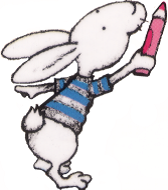 Illus by Sarah GillMaybe Lucy Rowland's blog post last week has inspired you with ideas for potential picture books. If you're itching to write, this week's blog post aims to help.
Illus by Sarah GillMaybe Lucy Rowland's blog post last week has inspired you with ideas for potential picture books. If you're itching to write, this week's blog post aims to help.For over ten years I tutored adult education courses on writing children’s picture books. For their first homework I'd get students to type out the text of a picture book where the author and illustrator weren't the same person. This helped demystify picture books and the students would then swap the typed stories and imagine potential illustrations before seeing the 'real' picture books. Although picture book writers don't need to be able to illustrate, it helps to be able to think visually.
During the course I gave students a sheet that listed brief reminders on what we’d covered over the weeks. I thought Picture Book Den readers might like this too. I’ve adapted it and added lots of LINKS to more detailed advice by myself and others at the Den. However, please remember that not every story has to follow all the points raised and I haven’t discussed everything.
Perhaps to begin, just write the story YOU want to write and then think about the points below, otherwise your brain may explode with too much information! Anyway, there are always exceptions and sometimes 'how to' advice only helps when you suspect something doesn't work. Plus always remember to read lots and lots of contemporary picture books and when they're classics ask yourself why they have stood the test of time.
So, in no particular order of importance...
1) Picture books are written to be read out loud so read your story aloud when writing. And if you're feeling brave, listening to somebody else read your text can be illuminating (depressing?!) as we all read differently.
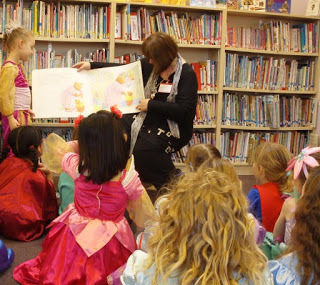
2) As the story is read by an adult to a child, it should appeal to both of them and be able to withstand frequent rereading. Otherwise the adult will be tempted to hide the book or the child will be bored and feed it to a ravenous dog.
3) At its most simple, a story is a problem that needs to be solved. This central problem that drives the plot should be something that matters to a child. So depending on your intended readership, think about what is important to a pre-school child. And assuming your main character is a child (human or animal) then they must solve the problem, not a know-it-all adult.
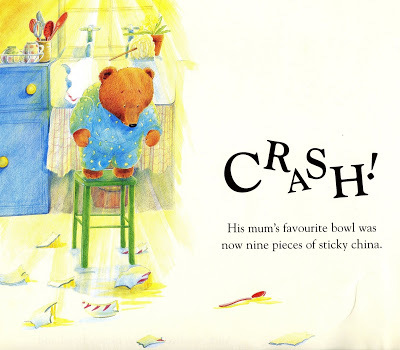 I'll Always Love You by Paeony Lewis and Penny Ives (Little Tiger Press)
I'll Always Love You by Paeony Lewis and Penny Ives (Little Tiger Press)In this story Alex breaks his mum's favourite honeybowl, will she still love him?
As an adult, we know we'll still be loved if we make a small mistake,
but a young child may be unsure and worry.
This book has done well for many years and it helps that the
'problem' is child orientated.4) If you want to interest a mainstream publisher in your story then be aware that they’ll need to sell internationally and will translate your story. That story about a hungry robin swooping into Sainsburys and grabbing a bag of frozen Yorkshire puddings for a Sunday roast and then driving away on the left-hand side of the road in a Reliant Robin is going to confuse children in China or Brazil (OK, or anywhere!).
5) Animals are popular in picture books because they’re cute. Also, they can find themselves in situations that might be dangerous for a child, such as getting lost in the wood or wielding a power saw (the more realistic the story and illustration, the more you need to think about this). Plus an animal is the same whatever part of the world you’re from and therefore more relatable. Having said this, some editors prefer humans.
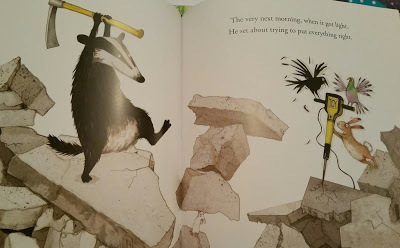 From Tidy by Emily Gravett (Two Hoots, 2016)
From Tidy by Emily Gravett (Two Hoots, 2016) It's probably more acceptable and believable for a young bunny to use a pneumatic drill
than a realistically drawn human child
6) Unless you’re self-publishing or are a quality illustrator, you don’t need to be able to illustrate or find an illustrator. The publisher arranges this and you’ll rarely get a choice. If you dislike sugary, cute rainbow-ribboned bears but the experienced publisher insists they’d be perfect, tough luck, the publisher is investing thousands of pounds in the book, not you.
 From The Yes by Sarah Bee and Satoshi Kitamura (Andersen Press, 2014)
From The Yes by Sarah Bee and Satoshi Kitamura (Andersen Press, 2014)I wonder what the illustrator thought when he first saw the text for this challenging picture book?
The slightly abstract illustrations and expressive text design are a brilliant fit for the slightly abstract text.
It's an example of how publishers are usually good at finding the right illustrator for a text.7) Language can be rich in picture books because the story is read aloud by an adult. It’s the reading schemes and early chapter books for children aged 5-7 years that use simple language because they are learning to read independently. This doesn't apply to picture books, unless they are picture books aimed at older children. Plus think about how the words sound and flow. Perhaps there is a rhythm or they sound lyrical or are full of bounce.
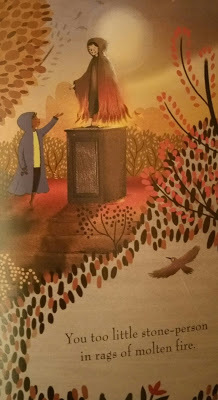 From Come All You Little Persons by John Agard and Jessica Courtney-Tickle
From Come All You Little Persons by John Agard and Jessica Courtney-Tickle(Faber and Faber, 2017) Picture books can be akin to poetry and aren't always straight forward.
8) Rhyme can be fun if it is of VERY good quality. I avoid it because I don’t have an ear for perfect meter. Plus finding the right rhyme mustn’t be at the expense of the story. I’d often be mean with students and if they wanted to submit a story in rhyme then they had to produce a prose version too. Translating rhyme can be difficult and the French version of The Gruffalo is in prose.
9) Unless you're an incredible illustrator, it's better to concentrate on a good story. There are all sorts of different picture books, but if you don't illustrate it might be easier to stick with more traditional formats, though don't let that stop you (here's a blog post by Pippa Goodhart on how she got a non-story picture book published).
10) Interaction and fun appeal to many children (eg noises, flaps and questions).
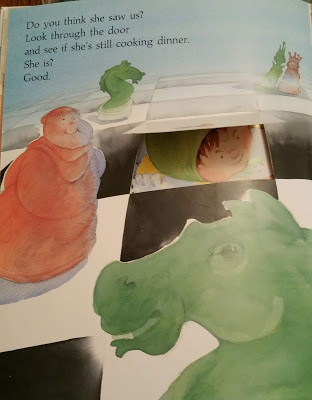 From Shhh! by Sally Grindley and Peter Utton
From Shhh! by Sally Grindley and Peter UttonA favourite for sharing with brave children - they adore whispering,
following the instructions and opening flaps, etc.
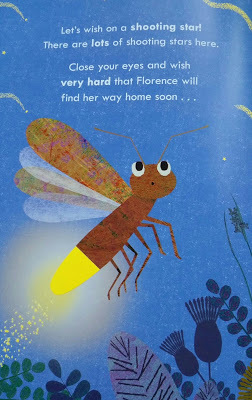 From Firefly Home by Jane Clarke and Britta Teckentrup (Nosy Crow, 2018)
From Firefly Home by Jane Clarke and Britta Teckentrup (Nosy Crow, 2018)There are lots of opportunities for the child to help the firefly find
her way home in this beautifully illustrated story.
11) Repetition and patterning can help provide structure and children enjoy being able to predict parts of the story and join in. A clear structure helps when listening to a story as otherwise the child can be confused and lose focus.
 From Goodnight Already by Jory John and Benji Davies (HarperCollins, 2015)
From Goodnight Already by Jory John and Benji Davies (HarperCollins, 2015)The child can predict what will happen when the duck wakes up the bear
and will enjoy joining in with the frustrated 'No.' Poor bear!
12) Humour is frequently a winner. An agent once told me to have more fun and I remind myself of this when I feel a story is flagging.
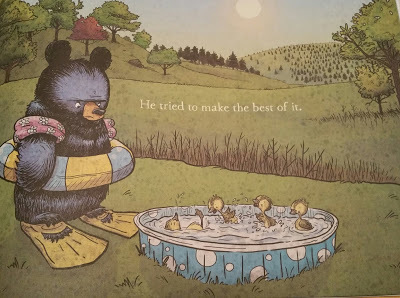 From Mother Bruce by Ryan T Higgins (Hyperion, 2015).
From Mother Bruce by Ryan T Higgins (Hyperion, 2015). Full of wry humour aimed at adult and child - it's a little dark and I laugh too.
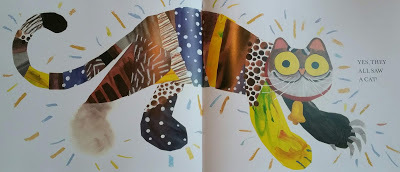 From They All Saw A Cat by Brendan Wenzel (Chronicle Books 2016)
From They All Saw A Cat by Brendan Wenzel (Chronicle Books 2016)Humour can be subtle and still be effective, such as in
this thoughtful book about seeing the world from different points of view (I adore it).
13) The Rule of Three can sometimes help a story - it's all explained in the link (this blog post is getting too long!).
14) Word length. A story is as long as it needs to be but 400-500 words is often suggested. Writing short texts is a skill. If you can write a story in 100 words, brilliant! Write you story and then revise and cut, cut and cut. Nobody gets it perfect first time, though don't cut the life out of your story.
15) When writing and revising your story always keep in mind what’s at the heart of the story. This is VITAL and you should be able to describe what your story is about in one or two sentences. Coming up with a good title helps too.
16) Text and illustrations combine to tell story, so allow plenty of opportunity for a variety of images. There can be a visual theme/joke that’s not in words.
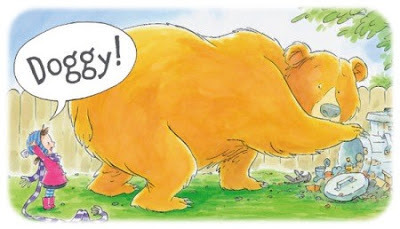 From Silly Doggy by Adam Stower (Templar, 2011)
From Silly Doggy by Adam Stower (Templar, 2011)The reader can see it's a bear and not a dog, which adds to the delicious amusement,
though the text never mentions it's a bear.
17) If your writing has a strong, distinctive voice/style then that’s brilliant. If you hear a Lauren Child story you know it’s her and vivid characterisation is part of this, which leads to the next point.
18) Characterisation. If your characters aren’t alive in your imagination then they won’t come alive on the page. Think about your main character’s personality and how this comes across in their actions and words. And if you're struggling to bring life to your character, experiment with writing in the first person to get to know your character better.
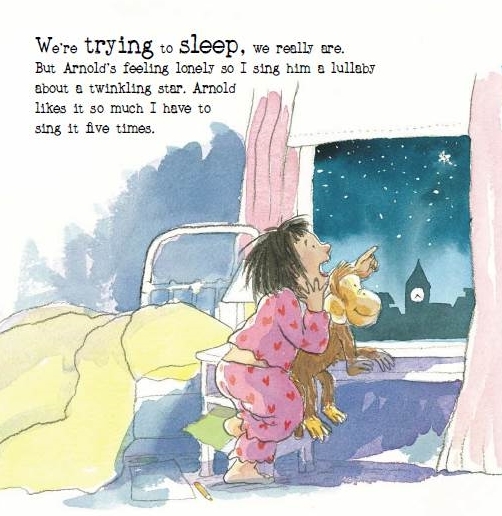 No More Yawning by Paeony Lewis and Brita Granstrom (Chicken House)
No More Yawning by Paeony Lewis and Brita Granstrom (Chicken House)If you read the text I hope you'll get an inkling of Florence's determined character.
In my imagination I can hear her emphasising 'have' in 'I HAVE to sing it five times'!
19) A fun, satisfying twist at the end is a bonus. There's more on endings here.
20) Making a simple b/w dummy picture book (stickmen are fine) can help the writer. There’s no need to send this to a publisher unless you’re an illustrator. The traditional 32 pages of a picture book typically allows 24 pages of story (i.e. approx. 12 double-page spreads). If you’re an illustrator you’d also send a publisher just two or three high-quality illustrated colour spreads (not originals and don’t bother doing more as editors always want changes).
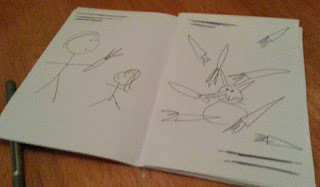 A dummy (for your eyes only!) of 8 sheets of A4 folded in half
A dummy (for your eyes only!) of 8 sheets of A4 folded in half can help a writer visualise how a story progresses.
21) Think about the overall structure of the picture book. For example, it might be 3/6/3 which equates to three spreads for the beginning, six spreads for the middle and three spreads for the resolution.
22) Your final manuscript can be presented in paragraphs with no divisions into pages, or in the UK you can divide it into 12-15 spreads (safest to keep to 12). I do this because I feel the page turn is part of the story, but opinion varies and don't divide into spreads if submitting to the US.
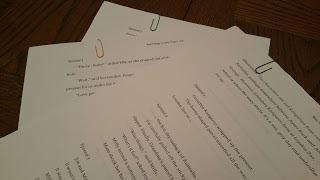
23) Writers shouldn’t include instructions on illustrations unless something is vital and not understandable from just reading the text. If a lot of illustration notes are essential then send an editor two manuscripts, one with the notes and one without.
24) Remember, even the most renowned of picture book authors write many more picture book texts than are ever published. The ratio varies but I know of one experienced, best-selling, award-winning author who only gets 1:9 published. So don’t despair when your first stories aren’t snapped up –it’s part of being a picture-book author and not pleasant, but that's life. Alternatively, perhaps self publish your book if you feel strongly about one specific story.
At the Picture Book Den there is multitude of great blog posts on writing picture books (naturally, it's a bit of an obsession with us). Using key words and phrases in the 'Search this blog' option on the right of our Home Page will bring up a huge variety. For example, try typing the phrase 'writing picture books'. Happy writing!
Paeony Lewis www.paeonylewis.com
Published on June 03, 2018 23:30
May 27, 2018
Where do you get your ideas from? by Lucy Rowland
In April, Lynne Garner wrote a blog post for Picture Book Den called ‘Having Fun Making Stuff Up’. She spoke about attending a writing retreat with the Scattered Authors Society. During the retreat, Lynne took part in a workshop where she was encouraged to use drawing as a way to generate ideas for picture books. http://picturebookden.blogspot.co.uk/2018/04/having-fun-making-stuff-up-lynne-garner.html
As many authors and illustrators know, one of the most popular questions we get asked is….‘Where do you get your ideas from?’ and it can be quite a tricky question to answer because the truth is ideas really are everywhere! And yet, I still find it interesting to hear what people say. Their answers often make me realise how a method that works for one author or illustrator might not be the best approach for another. But it also shows there is no right or wrong way to find ideas.
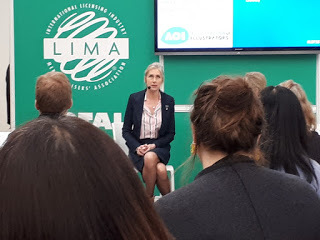
At the London Book Fair this year, I was excited to attend a talk from our Children’s Laureate, Lauren Child. As part of her laureateship, Lauren wants to encourage people to ‘let children dawdle and dream’. She wants to set up a challenge on her website for people to ‘Look Down’and notice, as they walk around, the small, forgotten or misplaced items on the floor and to consider what the story around these objects could be. It reminded me of another post by Lynne Garner where she challenged Picture Book Den readers to make up a story based on some of the objects she’d photographed on a walk. http://picturebookden.blogspot.co.uk/search/label/Lynne%20Garner?updated-max=2017-10-23T07:00:00%2B01:00&max-results=20&start=3&by-date=false
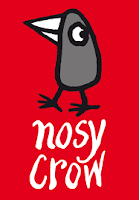 I once heard author, Tracey Corderoy, speaking at a Nosy Crow ‘Picture Book Master Class’. For Tracey, looking through illustrators’ work and finding interesting characters can spark her to wonder ‘what could this character’s story be?’ Picture book author, Lou Carter, also told me that she often writes a story around a character. The character is very much the starting point for her. I found this really interesting as it’s something I rarely do. Perhaps it’s because I’m not such a visual person? Maybe this is also why I don’t use drawing to come up with new ideas?
I once heard author, Tracey Corderoy, speaking at a Nosy Crow ‘Picture Book Master Class’. For Tracey, looking through illustrators’ work and finding interesting characters can spark her to wonder ‘what could this character’s story be?’ Picture book author, Lou Carter, also told me that she often writes a story around a character. The character is very much the starting point for her. I found this really interesting as it’s something I rarely do. Perhaps it’s because I’m not such a visual person? Maybe this is also why I don’t use drawing to come up with new ideas?
I often get my ideas because I like to play with words. My first book ‘Gecko’s Echo’ (with illustrator Natasha Rimmington) came about simply because I liked the sound of these words together. Next year, I have a second book coming out with Ben Mantle- I can’t reveal what it is called just yet but it also has a rhyming title that very much inspired the story and, again, this came about from playing with language. Mine and Kate Hindley’s latest book, ‘The Knight who said No’ was initially about a viking (rather than a knight) and this idea came to me when I was playing around with the words ‘The vikings are striking!’
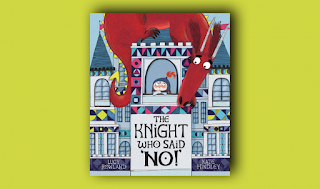
I’ve always loved rhyme and rhythm. Sometimes I find rhythms that I particularly enjoy and I see if I can write a story around that rhythm. For example, I love the rhythm in ‘Bad Sir Brian Botany’ by A.A.Milne:
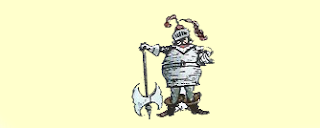 ‘Sir Brian woke one morning and he couldn’t find his battleaxe;He walked into the village in his second pair of boots.He had gone a hundred paces, when the street was full of faces,And the villagers were round him with ironical salutes.’
‘Sir Brian woke one morning and he couldn’t find his battleaxe;He walked into the village in his second pair of boots.He had gone a hundred paces, when the street was full of faces,And the villagers were round him with ironical salutes.’
I mean…What a fantastic rhythm!!
I was in Australia when I re-read this poem and that evening I was looking at the fruit bats in the trees. I then asked myself that very important question that we often ask ourselves as authors and illustrators…WHAT IF? ‘What if there was a fruit bat who didn’t like fruit?...what would happen then?’And I wrote around the Sir Brian rhythm as a challenge to see if I could do it.
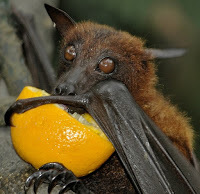 ‘Once there was a fruit bat and the fruit bat’s name was Jeremy.Jeremy had always felt he didn’t quite belong.No he wasn’t like the others and his sisters and his brothersUsed to look at him and giggle ‘cause he always got it wrong.And worst of all were mealtimes. Jeremy just dreaded them.His brothers and his sisters used to think it was a hoot!See it isn’t very easy when your dinner makes you queasy And Jeremy refused to try a single bite of fruit.’
‘Once there was a fruit bat and the fruit bat’s name was Jeremy.Jeremy had always felt he didn’t quite belong.No he wasn’t like the others and his sisters and his brothersUsed to look at him and giggle ‘cause he always got it wrong.And worst of all were mealtimes. Jeremy just dreaded them.His brothers and his sisters used to think it was a hoot!See it isn’t very easy when your dinner makes you queasy And Jeremy refused to try a single bite of fruit.’
I use the ‘what if’ question a lot during my school visits. What if it really did rain cats and dogs? What if you woke up and your teachers had turned into zombies? What if children ruled the world? (Cue loud cheers from the class!) The children are generally fairly excitable by this point but I then encourage them to come up with their own ‘what if?’ ideas and their suggestions are truly brilliant! In fact, I might have to steal some of their ideas myself!
Further investigation into where people find inspiration taught me that Abie Longstaff sometimes uses the childhood games she played with her younger sisters as ideas for stories. Juliet Clare Bell uses the artwork hanging on her walls. Penny Dolan once wrote a guest blog for Picture Book Den and put it brilliantly…’Picture books are a pleasure to write once you’ve got an idea.’ One of the places she gets inspiration is from the schools themselves when she is doing school visits. http://picturebookden.blogspot.co.uk/search?q=penny+dolan
Ideas really do come from many different places and you might find that you have certain tendencies or preferences when hunting for your own? So….Where do you get your ideas from?
As many authors and illustrators know, one of the most popular questions we get asked is….‘Where do you get your ideas from?’ and it can be quite a tricky question to answer because the truth is ideas really are everywhere! And yet, I still find it interesting to hear what people say. Their answers often make me realise how a method that works for one author or illustrator might not be the best approach for another. But it also shows there is no right or wrong way to find ideas.

At the London Book Fair this year, I was excited to attend a talk from our Children’s Laureate, Lauren Child. As part of her laureateship, Lauren wants to encourage people to ‘let children dawdle and dream’. She wants to set up a challenge on her website for people to ‘Look Down’and notice, as they walk around, the small, forgotten or misplaced items on the floor and to consider what the story around these objects could be. It reminded me of another post by Lynne Garner where she challenged Picture Book Den readers to make up a story based on some of the objects she’d photographed on a walk. http://picturebookden.blogspot.co.uk/search/label/Lynne%20Garner?updated-max=2017-10-23T07:00:00%2B01:00&max-results=20&start=3&by-date=false
 I once heard author, Tracey Corderoy, speaking at a Nosy Crow ‘Picture Book Master Class’. For Tracey, looking through illustrators’ work and finding interesting characters can spark her to wonder ‘what could this character’s story be?’ Picture book author, Lou Carter, also told me that she often writes a story around a character. The character is very much the starting point for her. I found this really interesting as it’s something I rarely do. Perhaps it’s because I’m not such a visual person? Maybe this is also why I don’t use drawing to come up with new ideas?
I once heard author, Tracey Corderoy, speaking at a Nosy Crow ‘Picture Book Master Class’. For Tracey, looking through illustrators’ work and finding interesting characters can spark her to wonder ‘what could this character’s story be?’ Picture book author, Lou Carter, also told me that she often writes a story around a character. The character is very much the starting point for her. I found this really interesting as it’s something I rarely do. Perhaps it’s because I’m not such a visual person? Maybe this is also why I don’t use drawing to come up with new ideas?I often get my ideas because I like to play with words. My first book ‘Gecko’s Echo’ (with illustrator Natasha Rimmington) came about simply because I liked the sound of these words together. Next year, I have a second book coming out with Ben Mantle- I can’t reveal what it is called just yet but it also has a rhyming title that very much inspired the story and, again, this came about from playing with language. Mine and Kate Hindley’s latest book, ‘The Knight who said No’ was initially about a viking (rather than a knight) and this idea came to me when I was playing around with the words ‘The vikings are striking!’

I’ve always loved rhyme and rhythm. Sometimes I find rhythms that I particularly enjoy and I see if I can write a story around that rhythm. For example, I love the rhythm in ‘Bad Sir Brian Botany’ by A.A.Milne:
 ‘Sir Brian woke one morning and he couldn’t find his battleaxe;He walked into the village in his second pair of boots.He had gone a hundred paces, when the street was full of faces,And the villagers were round him with ironical salutes.’
‘Sir Brian woke one morning and he couldn’t find his battleaxe;He walked into the village in his second pair of boots.He had gone a hundred paces, when the street was full of faces,And the villagers were round him with ironical salutes.’I mean…What a fantastic rhythm!!
I was in Australia when I re-read this poem and that evening I was looking at the fruit bats in the trees. I then asked myself that very important question that we often ask ourselves as authors and illustrators…WHAT IF? ‘What if there was a fruit bat who didn’t like fruit?...what would happen then?’And I wrote around the Sir Brian rhythm as a challenge to see if I could do it.
 ‘Once there was a fruit bat and the fruit bat’s name was Jeremy.Jeremy had always felt he didn’t quite belong.No he wasn’t like the others and his sisters and his brothersUsed to look at him and giggle ‘cause he always got it wrong.And worst of all were mealtimes. Jeremy just dreaded them.His brothers and his sisters used to think it was a hoot!See it isn’t very easy when your dinner makes you queasy And Jeremy refused to try a single bite of fruit.’
‘Once there was a fruit bat and the fruit bat’s name was Jeremy.Jeremy had always felt he didn’t quite belong.No he wasn’t like the others and his sisters and his brothersUsed to look at him and giggle ‘cause he always got it wrong.And worst of all were mealtimes. Jeremy just dreaded them.His brothers and his sisters used to think it was a hoot!See it isn’t very easy when your dinner makes you queasy And Jeremy refused to try a single bite of fruit.’I use the ‘what if’ question a lot during my school visits. What if it really did rain cats and dogs? What if you woke up and your teachers had turned into zombies? What if children ruled the world? (Cue loud cheers from the class!) The children are generally fairly excitable by this point but I then encourage them to come up with their own ‘what if?’ ideas and their suggestions are truly brilliant! In fact, I might have to steal some of their ideas myself!
Further investigation into where people find inspiration taught me that Abie Longstaff sometimes uses the childhood games she played with her younger sisters as ideas for stories. Juliet Clare Bell uses the artwork hanging on her walls. Penny Dolan once wrote a guest blog for Picture Book Den and put it brilliantly…’Picture books are a pleasure to write once you’ve got an idea.’ One of the places she gets inspiration is from the schools themselves when she is doing school visits. http://picturebookden.blogspot.co.uk/search?q=penny+dolan
Ideas really do come from many different places and you might find that you have certain tendencies or preferences when hunting for your own? So….Where do you get your ideas from?
Published on May 27, 2018 22:00
May 20, 2018
Discovering Ernest Aris, by Pippa Goodhart
I have just helped my 90 year old mother to pack up what has been the family home for more than half a century so that she could move into the house next to us. Oh, the amount of STUFF we had to sort!
There were many books to consider, including numerous worthy Sunday School prize books awarded to virtuous grandparents and uncles and aunts. But then one tatty little book that came to light -
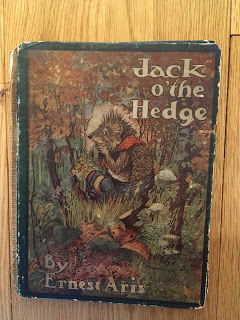
My mother told me that this little picture book was the one book that my father had kept from his young childhood. Did he have other books, or was this the one children's book he had from his early years? I don't know. He was born, the child of a family most of whom worked in the local woollen mills in Bradford, in 1913. Here he is with his prized cockerel, I imagine at an age when he had largely grown out of Jack o'the Hedge, but clearly, because it survived with him, still owned it -

So I have now carefully opened Jack o'the Hedge and read it. It isn't very good at all as a story, at least by modern standards. Its confusing because there both a Jack and Jackie amongst the many characters. And there's a male elf called Tink-a-bell. The story maunders on through a number of chapters, all rather quaint and not getting anywhere very much. But the pictures of wild animals dressed in clothes, all living in realistic woodland are charming.
I looked up Ernest Aris, having never come across that name before, and it turns out that he was a prolific writer and illustrator of children's books. He lived from 1882 to 1963, creating up to four hundred books in that time. He studied art in Bradford. Did my father's parents or other family come across him in person, I wonder?
Look at his pictures (from other books) -


Do they remind you anybody? He was creating books for children at the same time as Beatrix Potter was, and, fascinatingly, came into professional contact with her.
Naughty Ernest Aris had plagiarised Jemima Puddleduck into his own Mrs Beak Duck book. Apparently Beatrix Potter was rather taken with his artwork for that, and actually commissioned some work from him as a present for a niece, and then suggested to Warne, her publisher, that they get him to illustrate some of her stories since her sight was failing and she was busy. This is one of Ernest's pictures for a proposed book by Beatrix Potter -

Those elves in their bright red are much more Aris than Potter!
Aris then pushed things too far by publishing a story book of his own about a rabbit called Peter, and Warnes got cross. Seemingly Beatrix Potter herself was more amused than cross. Aris apologised to her, and the two went their separate bookish ways with Ernest Aris then producing work under the names of Robin A Hood and Dan Crow.
Like Beatrix Potter, Ernest Aris was all for merchandising his creations. He produced jigsaws and cigarette cards. One of his greatest success of all was in creating little figures called coco cubs for an advertising campaign to promote Cadbury's cocoa. There are many different figures for children to collect, and, there is something quite Beatrix Potterish about them.
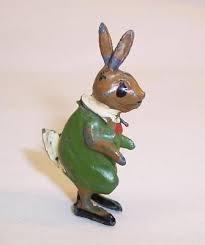
My question is, why has the more prolific and brighter-imaged Ernest Aris work disappeared from our cultural memories whilst Beatrix Potter has proved to have the staying power to be more popular than ever over the same time period? I think its to do with the quality of the stories.
Published on May 20, 2018 16:30
May 13, 2018
How to Catch a Reader: Make Up Cool (Fibs) Stuff! • by Natascha Biebow
 From Calvin & Hobbes by Bill WatersonCan you tell the truth from a bunch of made-up imaginings, er . . . fibs, when someone is spinning a really good yarn? Do your stories masquerade as believable ‘truths’?
From Calvin & Hobbes by Bill WatersonCan you tell the truth from a bunch of made-up imaginings, er . . . fibs, when someone is spinning a really good yarn? Do your stories masquerade as believable ‘truths’? One of the most admired qualities of storytellers is their amazing ability to convince readers that their yarns could be true, and maybe really ARE true . . .
This is because the premise and their characters are believable, which makes readers want to go the story’s journey. And, in doing so, they are helping readers to figure out some important stuff about their world.
Take REALLY REALLY by Kes Gray and Nick Sharratt:
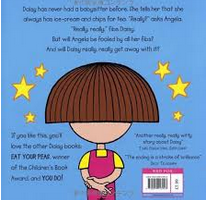
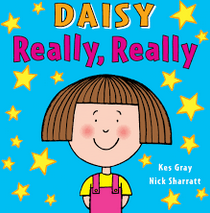
When Daisy gets a babysitter for the first time, she eats her mum's note and tells the her sitter all kinds of more and more elaborate fibs – testing, testing, but also working her way through this new experience. All the while, her fingers are safely crossed behind her back!
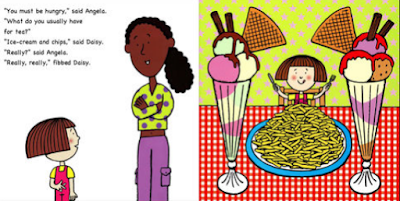 From Really, Really by Kes Gray and Nick Sharratt
From Really, Really by Kes Gray and Nick Sharratt In OLIVIA SAVES THE CIRCUS by Ian Falconer, Olivia is invited by her teacher to tell the class about her holiday.
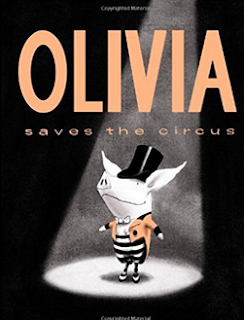
The story starts innocuously enough – Olivia’s mum took her and her brother to the circus. But then . . .
. . . the circus people were off sick and only Olivia could do all the acts!
She was Olivia the Tattooed Lady, Olivia the Lion Tamer, Olivia the Tight-rope Walker, the Clown, and Olivia the Queen of the Trampoline, and Madame Olivia and her trained dogs. She was FAMOUS!
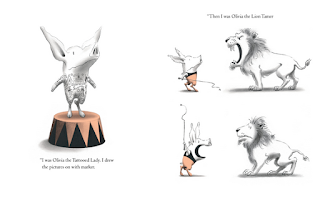 From Olivia Saves the Circus by Ian Falconer
From Olivia Saves the Circus by Ian Falconer
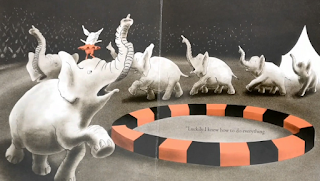 From Olivia Saves the Circus by Ian Falconer
From Olivia Saves the Circus by Ian Falconer Olivia’s teacher is skeptical. “Are you sure, Olivia?”
“To the best of my recollection.”
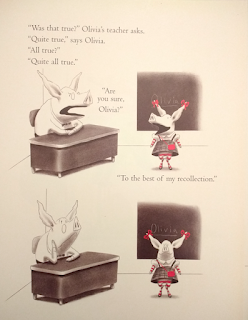 From Olivia Saves the Circus by Ian Falconer
From Olivia Saves the Circus by Ian Falconer Her deadpan response is of course what makes the story humorous, however, it is also a beautifully observed picture of the lying game.
So why do children (and grown-ups) tell fibs and stories?
Young children can’t actually tell the difference between a fact and a lie until they are around two years old. This is because they don’t have the ability to get into another person’s shoes yet. The first lies they learn to tell are those where they say they deny doing something.
From the age three, young children also begin to tell white lies, such as to hide a surprise or to thank someone for a present even when they don’t really like it.
Take the classic NO ROSES FOR HARRY by Gene Zion and Margaret Blog Graham.
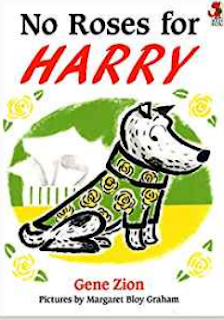
Harry is a white dog with black spots. On his birthday, he is given a lovely homemade jumper from Grandma. But it has roses on it. “It was the silliest sweater he’d ever seen.”
 From No Roses for Harry by Gene Zion and Margaret Bloy Graham
From No Roses for Harry by Gene Zion and Margaret Bloy GrahamTHE LIE: It wouldn’t do to tell Grandma. Harry wears the sweater dutifully, but he’s sure the other dogs will laugh at him.
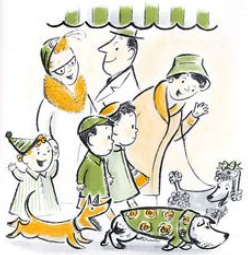 From No Roses for Harry by Gene Zion and Margaret Bloy Graham
From No Roses for Harry by Gene Zion and Margaret Bloy GrahamEventually, the sweater unravels and a bird makes a nest out of the wool. Harry doesn't tell anyone.
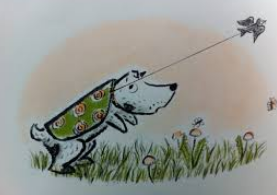 From No Roses for Harry by Gene Zion and Margaret Bloy GrahamBut then: disaster! Grandma is coming to visit!
From No Roses for Harry by Gene Zion and Margaret Bloy GrahamBut then: disaster! Grandma is coming to visit!
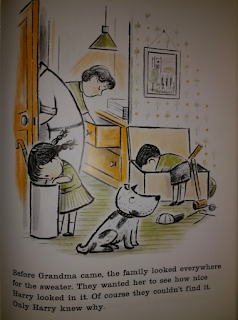 From No Roses for Harry by Gene Zion and Margaret Bloy Graham
From No Roses for Harry by Gene Zion and Margaret Bloy Graham THE SORT-OF-TRUTH: Harry feels compelled to show Grandma what’s become of the sweater (she thinks Harry has been incredibly generous). Best of all, at Christmas, Harry gets a new sweater – white with black spots. This time, he loves it!
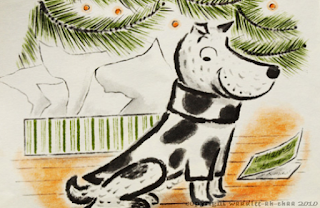 From No Roses for Harry by Gene Zion and Margaret Bloy GrahamBeing able to tell a fib or a believable story is often a way in to becoming socially acceptable, on the finely balanced scales of weighing up right and wrong. It’s also a sign that children are developing important cognitive skills such as ‘theory of mind’, the ability to recognize that others have different beliefs or feelings than they do, which develops slowly in the preschool and kindergarten years.
From No Roses for Harry by Gene Zion and Margaret Bloy GrahamBeing able to tell a fib or a believable story is often a way in to becoming socially acceptable, on the finely balanced scales of weighing up right and wrong. It’s also a sign that children are developing important cognitive skills such as ‘theory of mind’, the ability to recognize that others have different beliefs or feelings than they do, which develops slowly in the preschool and kindergarten years.In Sarah McIntyre's poignant story THE NEW NEIGHBOURS
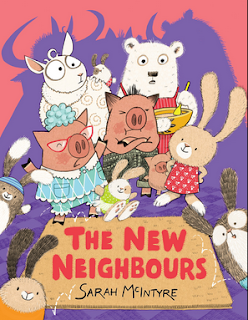
the whole tower block is convinced that the rats who have moved into the ground floor are "big, dirty, thieveing, dangerous rats" before they have even met them . . .
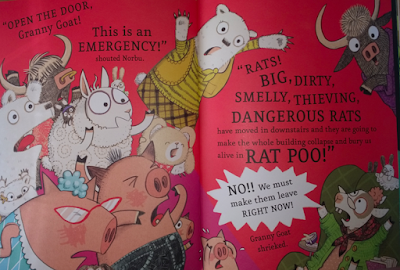 From The New Neighbours by Sarah McIntryeBut when they finally get to meet the pair of tiny, neat and friendly new neighbours in person, the friends are hugely embarrassed by the rats' kind invitation to come in and share CAKE. Lettuce doesn't want to admit the crazy stories they'd made up, so she fibs:
From The New Neighbours by Sarah McIntryeBut when they finally get to meet the pair of tiny, neat and friendly new neighbours in person, the friends are hugely embarrassed by the rats' kind invitation to come in and share CAKE. Lettuce doesn't want to admit the crazy stories they'd made up, so she fibs: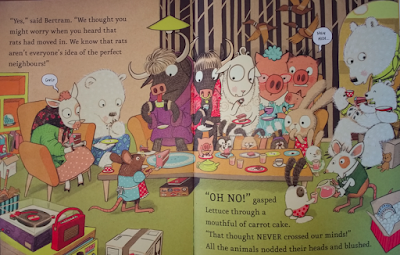 From The New Neighbours by Sarah McIntrye
From The New Neighbours by Sarah McIntrye So, if I’m a writer, can I fib as much as I like? Will I be believed?
In John Burningham’s JOHN PATRICK NORMAN McHENNESSY, THE BOY WHO WAS ALWAYS LATE, the lines between what is true and what is a fib are seemingly clear until the tables are turned and the grown-up teacher fibs. Or is it everything John has been saying really The Truth?
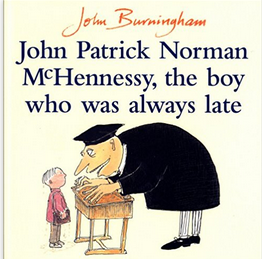
John Patrick Norman McHennessy spins all kinds of yarns to convince his teacher why he is late for school. He has met a crocodile, a lion and even a tidal wave! Of course, his teacher does not believe him.
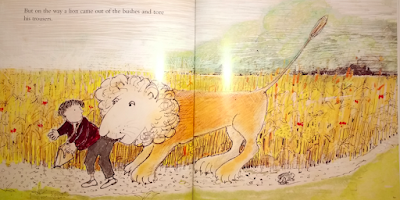 From John Patrick Norman McHennessy by John Burningham
From John Patrick Norman McHennessy by John Burningham But when his teacher is captured by a big hairy gorilla, John replies there are no such things as big hairy gorillas. Who’s telling what truth and what is the fib?
I would venture that telling made-up ‘truths’ is something authors are wired to do. As I tell stories, I reach back into my past, I tell about encounters and observations from last week and dig deep for tales inspired by my childhood. I embroider. My stories are inspired by where I’ve been and where I want to go, and this helps me find my bearing on what is true for me today. By telling stories, I am making something ‘real’, even if it’s a big fat fib, conjuring it up in my mind’s eye.
We tell stories about things we need to be true.
We tell stories about things we wish were true.
We tell stories to avoid punishment or consequences.
Lying requires the child to hide the truth, plan up a storyabout it, tell someone about it, and remember it! So, we began practising our storytelling ‘lying’ skills right from when we're preschoolers.
Of course, as children get older they also develop their moral compass, so they can distinguish between right and wrong, what is made-up and what is true. They are encouraged to tell the truth.
Like in THE TRUTH ACCORDING TO ARTHUR, where Arthur tells all kinds of alternative versions of what really happened when he borrowed his brother’s big bike, accidentally wrecked it and scratched Mum’s car.
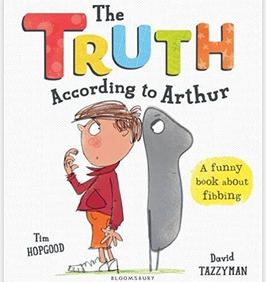
An alien did it! . . . A super cool princess borrowed the bike!
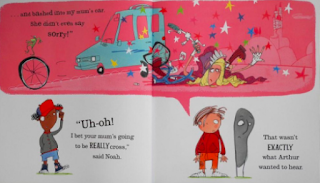 From The Truth According to Arthur by Tim Hopgood and David Tazzyman
From The Truth According to Arthur by Tim Hopgood and David Tazzyman The bike was really a robot! . . .
 From The Truth According to Arthur by Tim Hopgood and David Tazzyman
From The Truth According to Arthur by Tim Hopgood and David Tazzyman Arthur tries bending, stretching, disguising it, hiding, and ignoring The Truth . . . But eventually, when Mum asks what has happened, Arthur looks The Truth straight in the eye and confesses. It’s not nearly as interesting as the stories he was telling, but Mum is pleased he told The Truth.
A fun game I like to play is to imagine what the world will be like in the future. Will it be one where we can fly everywhere rather than use a car on a road? Wouldn’t it be spectacular if I could just go and see my mum in Brazil for a cup of tea and then be back in London in time for dinner? Will robots deliver our post?
If I can’t tell a story or a weensy-fib-imagined truth, I can’t invent the future. If I can’t imagine what we might invent to fill the gaps in our world, to solve our current problems, then I might be powerless to change anything. Stories help young readers feel empowered to imagine and to make stuff up.
When a story resonates, the reader will nod and say, “Yes, that’s true! Now listen to what happened when . . ." and tell his or her version of this ‘truth’. And so we are all linked by a circle of fibs, a circle of stories. (But we should really tell The Truth.)
_________________________________Natascha Biebow, MBE, Author, Editor and Mentor
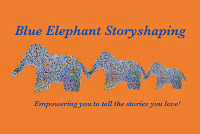 Natascha is the author of The Crayon Man (coming in 2019), Elephants Never Forget and Is This My Nose?, editor of numerous award-winning children’s books, and Co-Regional Advisor (Co-Chair) of SCBWI British Isles. She runs Blue Elephant Storyshaping, an editing, coaching and mentoring service aimed at empowering writers and illustrators to fine-tune their work pre-submission. Check out her Cook Up a Picture Book courses!
Natascha is the author of The Crayon Man (coming in 2019), Elephants Never Forget and Is This My Nose?, editor of numerous award-winning children’s books, and Co-Regional Advisor (Co-Chair) of SCBWI British Isles. She runs Blue Elephant Storyshaping, an editing, coaching and mentoring service aimed at empowering writers and illustrators to fine-tune their work pre-submission. Check out her Cook Up a Picture Book courses!
Published on May 13, 2018 19:00
May 6, 2018
DARWINISM FOR BEGINNERS: Picture books that introduce children to evolution • Jonathan Emmett

Until recently, the UK school curriculum did not require children to be taught about evolution until they reached secondary school. In September 2014, after years of lobbying by scientists and other groups, evolution was introduced into the final year (age 10-11) of the primary curriculum. While this is a step in the right direction, research has shown that children are more likely to accept evolution’s rational explanation of creation if they’re introduced to it towards the beginning of their primary education rather than at the end, by which time less-rational explanations (both religious and non-religious) may have taken root.
For the last few years I've been using my poem My Cousin is a Cucumber (from Skyboy and other Stupendous Science Stories ) to explain to Year 3 and 4 classes that all life on Earth is believed to have a single common ancestor. Most seven-year-olds are fascinated to learn that they are descended from an "itsy-bitsy blob of life" and amused to discover that they are the distant cousins of both cockatoos and cucumbers. An awareness of evolution is fundamental to a child’s proper understanding of the natural world and, if presented in an appropriate and engaging way, there is no good reason for evolution not to be introduced to children as young as five or six.
Picture books can be a very effective way to introduce evolution to children from an early age. How the Borks Became , my new picture book with Elys Dolan, was written specifically to explain natural selection, the process by which evolution takes place. It was developed in consultation with Boston University’s Child Cognition Lab who have been researching how to teach evolution effectively to young children. As a result of their research, the team developed their own natural selection picture book, How the Piloses Evolved Skinny Noses , which is aimed at a slightly older age group to How the Borks Became and explains the process in a more detailed way. You can find out more about the team’s research and their book at evolvingmindsproject.org.
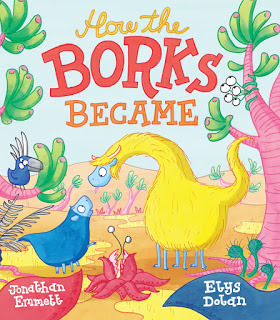
How the Borks Became follows the evolution of a fictional species, the llama-like Borks, who live on “a far distant planet, quite like our own Earth”. The books shows how three environmental factors - climate, predation and availability of food – result in Borks evolving from smooth-furred, short-necked, blue creatures into shaggy, long-necked, yellow ones.
 How the Borks Became shows how natural selection transforms the Borks from smooth-furred, short-necked, blue creatures into shaggy, long-necked, yellow ones.
How the Borks Became shows how natural selection transforms the Borks from smooth-furred, short-necked, blue creatures into shaggy, long-necked, yellow ones.The use of a fantasy species gives the book licence to represent the process of natural selection in a speeded-up, caricatured form over just four generations of Borks. A page at the end of the book explains that evolution on Earth happens at a far slower rate with much smaller changes and that it might take an Earth animal millions of years to change as much as the Borks in the story.
 When a greedy predator gobbles up all of the blue-furred borks, only the better-camouflaged yellow-furred Borks are left to parent the next generation.
When a greedy predator gobbles up all of the blue-furred borks, only the better-camouflaged yellow-furred Borks are left to parent the next generation.Here are five more picture books that do a great job of introducing the fundamentally important topic of evolution to children at primary school age.
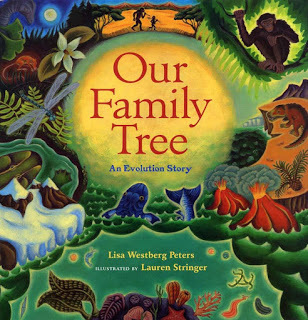 Our Family Tree: An Evolution Story
written by Lisa Westberg Petersillustrated by Lauren StringerSuitable for age 5 and above.
Our Family Tree: An Evolution Story
written by Lisa Westberg Petersillustrated by Lauren StringerSuitable for age 5 and above.This is a US picture book, but can easily be bought on import. Westberg Peter’s simple, poetic text charts the evolution of humans from our beginnings as simple mono-cellular organisms to the present day, highlighting significant stages along the way. Stringer’s illustrations intercut pictures of creatures in their natural habitats with images of a family mapping out an evolutionary diagram on a sandy beach. These sand drawings are cleverly employed to illustrate important developments in internal anatomy, such as the appearance of backbones and lungs. A glossary page and timeline at the back of the book give additional details and a sense of perspective to the book’s four billion year narrative.
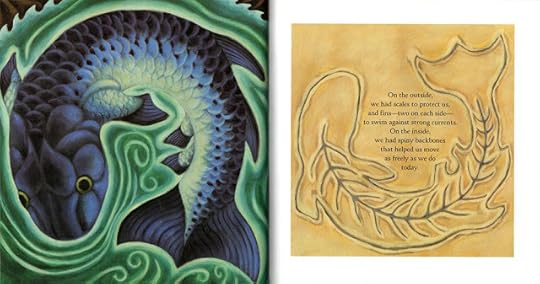 A spread from Our Family Tree, showing the development of fins and a backbone.
A spread from Our Family Tree, showing the development of fins and a backbone.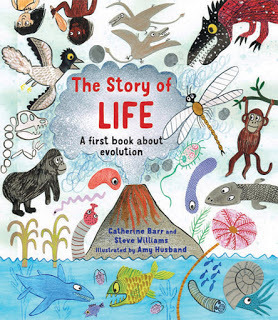 The Story of Life
written by Catherine Barr and Steve Williamsillustrated by Amy HusbandSuitable for age 6 and above.
The Story of Life
written by Catherine Barr and Steve Williamsillustrated by Amy HusbandSuitable for age 6 and above.This book covers an even longer timeline than Our Family Tree and charts the evolution of all life on Earth with the time period displayed in the corner of each page. Amy Husband’s lively illustrations display the diversity of Earth’s plant and animal life at various stages in its early history, before narrowing the focus to show the last 12 million years of human evolution from the the first apes to modern man on the last four spreads. The book finishes with an environmental message about the need to look after the planet that is our only home.
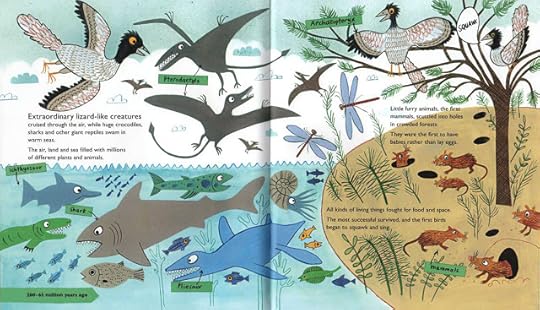 This spread from The Story of Life illustrates the diversity of life on prehistoric Earth.
This spread from The Story of Life illustrates the diversity of life on prehistoric Earth.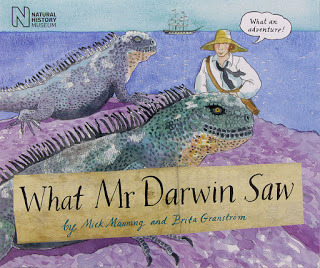 What Mr Darwin Sawby Mick Manningand Brita GranströmSuitable for age 7 and above.
What Mr Darwin Sawby Mick Manningand Brita GranströmSuitable for age 7 and above.Although the concept of evolution predated Charles Darwin, it was not widely accepted until Darwin discovered the principle of natural selection. Mick Manning and Brita Granström’s biographical picture book spans the life of this revolutionary scientist, but focusses chiefly on the five years the young Darwin spent as a captain’s companion and naturalist aboard the HMS Beagle. The book uses scenes from the voyage and excerpts from Darwin’s diary to show how his encounters with the plants and animals of South America, and the Galapagos Islands in particular, informed his subsequent work.
 What Mr Darwin Saw illustrates how Darwin’s experiences during the voyage of the HMS Beagle informed his later work.
What Mr Darwin Saw illustrates how Darwin’s experiences during the voyage of the HMS Beagle informed his later work. The Misadventures of Charles Darwinwritten by Isabel Thomasillustrated by Pete WilliamsonSuitable for age 9 and above.
The Misadventures of Charles Darwinwritten by Isabel Thomasillustrated by Pete WilliamsonSuitable for age 9 and above.This book, part of Oxford University Press’s Treetops in Fact series, presents an entertaining biography of Darwin’s life, from “stinky schoolboy” to aged “celebrity scientist”. It also does a great job of explaining Darwin’s theories clearly and succinctly and examines some of their implications for science and culture. Isabel Thomas’s engaging and accessible text is liberally peppered with archive photographs and Pete Williamson’s illustrations and ‘Mythbuster’ panels throughout the book help to correct common misconceptions about Darwin’s life and work.
 This spread from The Misadventures of Charles Darwin looks at how Darwin’s theories were initially received.
This spread from The Misadventures of Charles Darwin looks at how Darwin’s theories were initially received.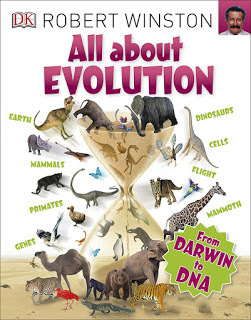 All About Evolution: From Darwin to DNAby Robert Winston(Previously published as Evolution Revolution)Suitable for age 10 and above.
All About Evolution: From Darwin to DNAby Robert Winston(Previously published as Evolution Revolution)Suitable for age 10 and above.This book, written by scientist and broadcaster Robert Winston is crammed with detailed information on every aspect on evolution, from its historical development as an idea, to its possible implications for the future of mankind. One minor criticism is that some spreads feel a little too crowded, making it difficult to take in the content, but this is easily forgiven given the breadth and quality of information the book contains. Although this book is probably more suited to secondary school readers, it contents will be of interest to more advanced and inquisitive readers in their final years of primary school as well.
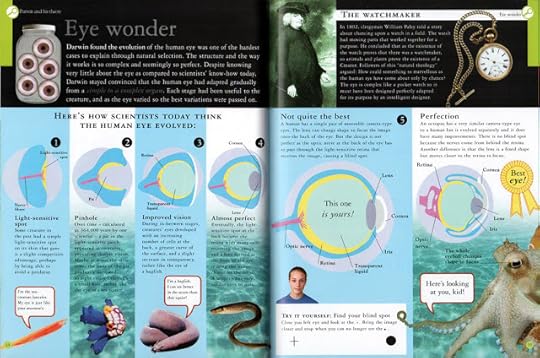 This spread from All About Evolution shows how scientists think complex structures like the human eye evolved via a series of incremental changes.
This spread from All About Evolution shows how scientists think complex structures like the human eye evolved via a series of incremental changes.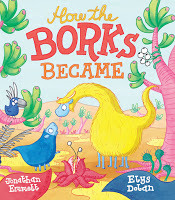 How the Borks Became An Adventure in Evolution by Jonathan Emmett and Elys Dolan is published by Otter-Barry Books. Find out more about the book and download some activity sheets here.
How the Borks Became An Adventure in Evolution by Jonathan Emmett and Elys Dolan is published by Otter-Barry Books. Find out more about the book and download some activity sheets here.Find out more about Jonathan and his books at his Scribble Street web site or his blog. You can also follow Jonathan on Facebook and Twitter @scribblestreet.
See all of Jonathan's posts for Picture Book Den.
Published on May 06, 2018 22:30
April 29, 2018
Read it - again, and again, and AGAIN! by Jane Clarke
Do you or a family member have a favourite picture book, read so many times that everyone knows it by heart - and can see the illustrations with his or her eyes shut?
Every night my 3 year old granddaughter requests
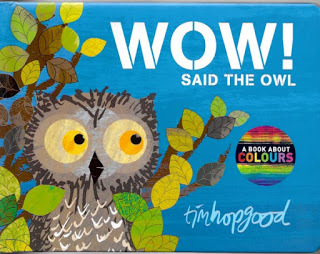 Wow! said the Owl by Tim Hopgood
Wow! said the Owl by Tim Hopgood
Yep. EVERY NIGHT. You might be able to slip in another book as well, but this one has to be the last book before sleep. It’s reassuring and upbeat, with a sense of wonder - and my 10 month old granddaughter already loves it, too.
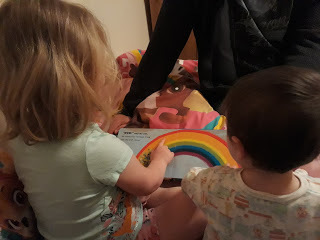
This is the one my 4 year old granddaughter in the USA currently requests most:
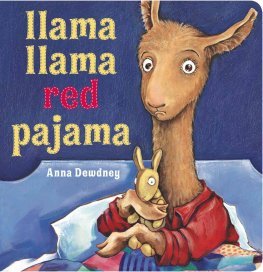 Llama llama red pyjama by Anna Dewdney
Llama llama red pyjama by Anna Dewdney
There are several picture books from my sons’ 1980s childhoods that I can visualise page by page because I was requested to read them again and again, and again. Top of the pile are:Henry’s Busy Day by Rod Campbell - with the much-stroked (and snot-wiped-off) furry ending that makes you go aaah.
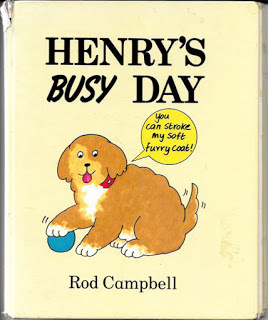
Dogger by Shirley Hughes was another huge favourite:
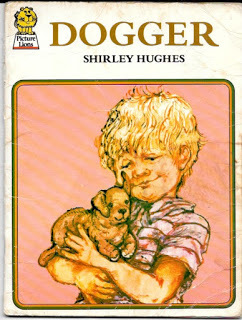
My sons totally identified with Dave and his toy dog. It’s quite a long book, so after the umpteenth reading, I’d attempt to skip the odd page, or summarise. They always caught me out.
Going further back, I realise that I must’ve been the same when I was a child, because I can still recite the entire text of this book and see all the illustrations in my mind’s eye:
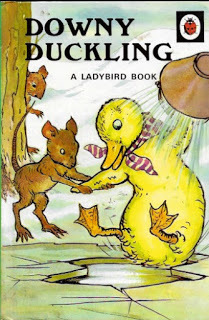 Downy Duckling by W Perring and AJ Macgregor (first published 1942! The original got lost somewhere down the line, but I was able to find a new edition, yay!)
Downy Duckling by W Perring and AJ Macgregor (first published 1942! The original got lost somewhere down the line, but I was able to find a new edition, yay!)
I remember the feeling of comfort and safety that this story gave me as a child, and finding it again is like a warm hug from the past. So what do all of these very different books have in common? I think it’s that they lull the child into his or her happy place. It might be too overt for today's tastes, but the ending to Downy Duckling nails it:
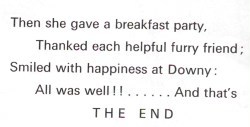
What picture books have you read again, and again, and AGAIN?
Jane's very happy to report that one of her four granddaughters is currently stuck on one of her books - Who Woke the Baby? illustrated by Charles Fuge - at one and a half she's too small to say why, but she clearly loves to roar at the lion and clap at the happy ending.
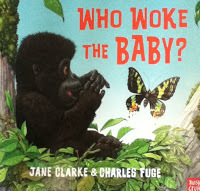
Every night my 3 year old granddaughter requests
 Wow! said the Owl by Tim Hopgood
Wow! said the Owl by Tim HopgoodYep. EVERY NIGHT. You might be able to slip in another book as well, but this one has to be the last book before sleep. It’s reassuring and upbeat, with a sense of wonder - and my 10 month old granddaughter already loves it, too.

This is the one my 4 year old granddaughter in the USA currently requests most:
 Llama llama red pyjama by Anna Dewdney
Llama llama red pyjama by Anna DewdneyThere are several picture books from my sons’ 1980s childhoods that I can visualise page by page because I was requested to read them again and again, and again. Top of the pile are:Henry’s Busy Day by Rod Campbell - with the much-stroked (and snot-wiped-off) furry ending that makes you go aaah.

Dogger by Shirley Hughes was another huge favourite:

My sons totally identified with Dave and his toy dog. It’s quite a long book, so after the umpteenth reading, I’d attempt to skip the odd page, or summarise. They always caught me out.
Going further back, I realise that I must’ve been the same when I was a child, because I can still recite the entire text of this book and see all the illustrations in my mind’s eye:
 Downy Duckling by W Perring and AJ Macgregor (first published 1942! The original got lost somewhere down the line, but I was able to find a new edition, yay!)
Downy Duckling by W Perring and AJ Macgregor (first published 1942! The original got lost somewhere down the line, but I was able to find a new edition, yay!)I remember the feeling of comfort and safety that this story gave me as a child, and finding it again is like a warm hug from the past. So what do all of these very different books have in common? I think it’s that they lull the child into his or her happy place. It might be too overt for today's tastes, but the ending to Downy Duckling nails it:

What picture books have you read again, and again, and AGAIN?
Jane's very happy to report that one of her four granddaughters is currently stuck on one of her books - Who Woke the Baby? illustrated by Charles Fuge - at one and a half she's too small to say why, but she clearly loves to roar at the lion and clap at the happy ending.

Published on April 29, 2018 22:30



